L. Andrew Cooper's Blog
October 16, 2025
Supercosmic Dark Heroes: No One Can Save Us by Kendall Phillips
Adam always keeps his powers in check. As the world’s only superhero, he must know his limits. Defeat the master criminal, repel an army, stop a natural disaster, but never let himself go too far.
Until Syangnom.
The world has grown accustomed to the feats of its only superhuman. Adam’s wife, Sara, a celebrated journalist and periodic hostage, regularly reports his exploits, and the agents of Extra-Judicial Affairs handle all the legal issues.
But when Adam becomes enraged in the reclusive regime of Syangnom, he leaves 14 million people dead and the world recoiling from the destruction he has wrought.
Now Adam’s wife Sara and EJA Agent Pia Mercado must track down the conspiracy behind Adam’s breakdown and discover the otherworldly source of his powers. Their search will bring them face to face with supervillains, eldritch gods, and the mysterious figure who defends Chicago from the shadows, the armored hero known only as No One.
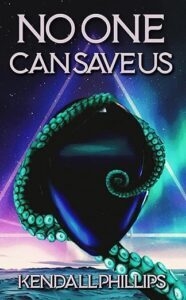 Click the image for more on Amazon!The Review
Click the image for more on Amazon!The ReviewThe fusion of comic book superhero action with Lovecraftian weird and mythos elements to form the backbone of Kendall Phillips’s No One Can Save Us places the book in rare company (think Dr. Strange), inviting readers to share in its deep indulgence of the thoughtful, scary fantastic.
What makes the book’s company even rarer is its addition of unsettling depth and realism in its characters, exemplified in the story’s depiction of the impact of charged-with-superheroic-powers Adam’s activities not just on the world but on his wife, Sara, who had the leading career in the relationship until he got his powers. Adam’s zealousness in protecting Sara, logically, makes Sara a target, a prisoner of his escapades, but with her own heroic streak, she rises to a series of challenges, becoming a protagonist rather than a background character waiting to be rescued. The sharp edge of Adam’s protective instinct and Sara’s response to it are only the beginning of how the story takes apart simple notions about superheroes and heroism. Score one for the title.
Another rare but logical aspect of superheroic existence that the book includes is government response, not just the violent stuff, which is familiar enough, but bureaucratic effort and meltdown, which is scary in a way that should remind us that Kafka and Lovecraft were contemporaries.
A lot of the real fun, though, is the action sequences, which flow in Phillips’s smooth prose like invisible editing of shots that cost millions and millions to produce, explosions and cars flying and OMFG superheroes mean supervillains with super-gadgets and super-weapons, and as the situation escalates, things get more super. The villains deserve special note. They’re as unusually well-rounded as the heroes, and they have wonderful toys, nanobots and giant robots capable of virtual magic. As the story progresses, things get messier, with lines between hero and villain becoming blurrier, which increases the dark fun.
As the story progresses, things also get weirder, and Lovecraft fans will enjoy a trip to Miskatonic University when the Lovecraftian elements start to take center stage. Characters contemplate their smallness compared to both the titanic monstrosities they face and the implications of the powers involved, invoking true cosmic horror. The tentacle count gets very, very high.
While the horrors are considerable, I’d say this novel is still mostly about heroes and heroism, so Phillips’s choice to put Homeric wordplay front and center is apt. The book offers itself as pure enjoyment, but if you’re so inclined, you can think of it as a meditation on heroes—in the tradition of Odysseus—who have enormous power. It considers who really might use such power to do some saving, the implications of the saving (or not saving), who needs to be saved, and who doesn’t. Salvation is, after all, big business. Cosmic business. Score two for the title.
The bottom line: No One Can Save Us is a romp with superheroes, supervillains, and Lovecraftian monsters, at times light-hearted and at times cosmically dark, that combines city-levelling action with well-crafted characters and prose that keeps the pages turning. The richness of its people and plot will reward genre fans and more casual readers alike.
The post Supercosmic Dark Heroes: No One Can Save Us by Kendall Phillips appeared first on L. Andrew Cooper's Horrific Scribblings.
August 22, 2025
COVER REVEAL: Battling Darkness and the Divine during CRAZY TIME (Second Edition)
Once again, I am indebted to the brilliance of cover designer Ruth Anna Evans:

Horrific Scribblings is publishing a second edition of my surreal horror novel Crazy Time. I adore the new cover and am happy to have made the book better in other, subtler ways. The story is not splatterpunk or “extreme” in the subgenre sense, but it is transgressive and very, very dark. People have been offended (yay!) and found it too damned weird (yay!), but otherwise, I haven’t had many complaints. But I haven’t had many readers, either, so I’m hoping this new edition will find Lily Henshaw, the main character and possibly my favorite creation, many new admirers.
Reviewers are at work! More information is coming!
Oh, what’s the book about?
On a dark urban highway, bright, introspective thirtysomething Lily Henshaw survives a brutal attack by men who announce that “It’s Crazy Time!” and kill her friends. Months later, still crushed by survivor’s guilt, Lily suffers another serious trauma—and another, and another, and another. Deaths, especially suicides, surround her, as do strange occurrences that, despite her agnosticism, seem to have Biblical import. She becomes convinced she is cursed like Job from the Bible, but unlike Job, she doesn’t assume God is the good guy. While intense stresses foster an unlikely romance with her boss, she goes on a quest for answers that involves a psychic, a Satanist, a Protestant preacher, and others, gaining resolve and a destination: the skyscraper where she might confront the supernatural forces aligned in a conspiracy to destroy her life.
If you haven’t read it–and chances are, you haven’t–prepare for a dark treat. The new edition drops November 18, 2025 in e-book and paperback. For sale now on Amazon.
The post COVER REVEAL: Battling Darkness and the Divine during CRAZY TIME (Second Edition) appeared first on L. Andrew Cooper's Horrific Scribblings.
July 30, 2025
COVER REVEAL: Psychology Gets Under the Skin in THE SKINNER EFFECT
After university authorities observe a gruesome experiment that psychologist Dr. Stanley Burrows performs on rats, an experiment during which one of his graduate student assistants is injured, Dr. Burrows and his only loyal assistant, Edward Pine, accept exile from the academic world and embrace new supporters who want them to do different sorts of experiments on human subjects. Dr. Burrows has limitless resources to develop innovative processes for behavioral conditioning that achieve extreme outcomes. He programs his subjects with violence so they will commit violence. Spurred by conclusions drawn from the thinking of radical behaviorist B.F. Skinner, he will use his subjects to demonstrate not only the bloody extremes for which he can program a “human” but also a new understanding of “the human” susceptible to programming.
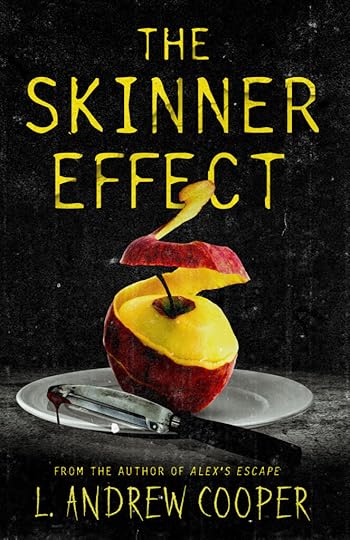 Click the image to order The Skinner Effect (~27,000 words, or 84 pages) on Amazon
Click the image to order The Skinner Effect (~27,000 words, or 84 pages) on AmazonCOVER ART BY THE MAGNIFICENT RUTH ANNA EVANS
“The Skinner Effect by L. Andrew Cooper is not for the faint of heart… a complex psychological experiment wrapped in an extreme horror disguise… fans of extreme horror will love this book.” –JG Faherty, author of Hellrider and The Malthusian Correction
“Somehow, the author manages to mix psychological horror with a gorefest and a bit of conspiracy theory on the side with excellent results in this book. Truly terrifying. This story will haunt my nightmares for a long time.” –Maria, ARC reviewer
“I can’t say I will now be frequenting the splatterpunk genre, but I know I will be reading more from L. Andrew Cooper. It’s dark, it’s messed up… I put my stomach aside and read it all. Ravenously. I know I will be reading this again in the future.
My only complaint is as the book progresses the horrors become so outlandish that I ceased to be fazed…
Or… maybe now I’m numb.
Perhaps…
Perhaps I’ve been conditioned.” –Jonny, ARC reviewer
The post COVER REVEAL: Psychology Gets Under the Skin in THE SKINNER EFFECT appeared first on L. Andrew Cooper's Horrific Scribblings.
July 2, 2025
Interview with Author Joseph Murnane: It Eats Your Hunger and Dead Rabbit
The talented Joseph Murnane shares some of his elegant prose in reflections on his novel It Eats Your Hunger and his novella Dead Rabbit. exploring how dangerous appetites become terrifying tales.
It Eats Your Hunger“It Eats Your Hunger is the kind of horror that takes up residence in your soul. It’s Hunter S. Thompson, it’s Kerouac, and it’s Straub. It’s shocking that this is Joseph’s debut novel. Many of the most seasoned writers couldn’t pull off the level of raw grit and honest, saw-tooth prose this book punches with.”
—Gage Greenwood, Author of On A Clear Day, You Can See Block Island
Ren has a problem, and it’s not his heroin addiction.
Or that he’s wanted for murdering his stepfather.
He’s being haunted by something far worse than the ghost of his dead sister.
When he hitches a ride with Lefty, Jersey, and Geena, a group of itinerant addicts on the run from their own problems, he starts to believe maybe things are looking up.
But there’s something wrong with Lefty. Something unnatural.
Something that wants to see them all dead.
Can Ren stop it in time, or will he end up torn apart on the side of the highway?
Or worse?
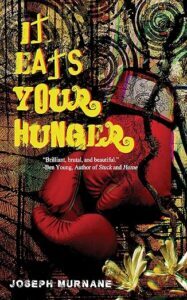 Click the image for more on Amazon!
Dead Rabbit
Click the image for more on Amazon!
Dead Rabbit
From the award-nominated author of It Eats Your Hunger comes the story of Adam Bell, a young man who accepts a job at Wild Mountain Wolf Sanctuary, a hidden facility in a secluded corner of the New Mexico desert. The work is hard but fulfilling, helping Adam come into his own and take hold of his humanity. However, beneath the earth, The Rabbit Man is awakening, a wretched terror hellbent on stripping that humanity away. Plagued by horrific visions and running out of time, he has a choice: fight to survive or become nothing more than a forgotten Dead Rabbit.
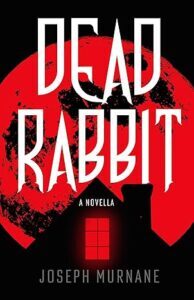 The Interview
The Interview1, Horror Class-ification. Before I read Gage Greenwood’s blurb (above), I’d already thought of your novel It Eats Your Hunger as blending aspects of Kerouac and Thompson with the supernatural horror genre (I didn’t think of Straub in particular). Are these authors influences, and if so, how? If not, why do you think people like me see connections? Your novel as well as your novella Dead Rabbit engage significantly with aspects of road narrative and American regionalism common to both Beat and Gonzo writing but also often—like a focus on disaffected, introspective youth coming of age, which you also have—qualify works as “literary.” Do you think of your work as literary? Why or why not? What’s at stake in calling a work “literary horror?”
JM: Thompson is probably the biggest influence in the bunch for me, but it wasn’t intentional. When I got that blurb back from Gage, it honestly made me quite weepy. It really meant a lot to me. Thompson is probably my favorite writer and was the reason I majored in journalism in college—at least until general life pulled me away from academia. I’ve always been attracted to the way he can swing from the most outlandish, probably-not-true-but-who-knows beats, over to deep, hard hitting truths that are as undeniable now as they were when they were written. Seriously, go back and read some of the essays in The Great Shark Hunt, maybe swap out the name of a politician or two, and it’ll be hard to tell they weren’t written for the era we live in.
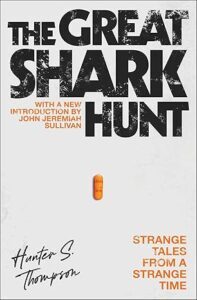
Not too long ago, I did my first speaking event where I read a few pages of Hunger and chose a topic to talk about in a mini-lecture. I decided to talk about “the truth in the lie,” as I like to call it, which for me is the heart of what I’m always shooting for. Especially with Hunger, it exists because I needed it to. It really helped me to process some things I still hadn’t quite allowed myself to feel, even years after the truths my lies are based on. I don’t just want to write scary stories, though of course that’s always at the forefront of my mind—this IS horror, after all— but I want to write stories that really mean something to people. I never saw a point in trying to write something until I felt like I really had something important to say. Does that make me literary? I honestly don’t know. I like to think it does, but in the end, I’ll leave that definition up to the people that encounter my body of work. For me, I’m just trying to say the things I need to in an entertaining and meaningful way.
2. Hunger I: The Feeding Experience. Another commonality It Eats Your Hunger shares with works by Beat and Gonzo writers is that it reports, in a fictionalized manner but with accuracy your afterword links to experience (and that I can partially confirm with my own experience), first-hand perceptions influenced by various drugs. To what extent do you set out to create fiction about altered states of consciousness? How might representing characters in altered states enhance your options for characterization? You represent various drugs that lead to diverse experiences: cocaine, LSD, a variety of opiates. Are you cataloguing different drugs’ highs and lows as characters take them to feed their appetites? Why or why not?
JM: Well, it’s not something I intend to make too much of my work about. I’d hate to pigeonhole myself, but addiction will come up as a theme from time to time. It’s been too much a part of my life not to. In Hunger, it’s not so much a cataloguing as a tool of characterization. They all have different “poisons.” so to speak, and in turn, I consider each of the different central characters little pieces of myself. Stuff like dream sequences, psychedelic trips, and the like all served to enhance this feverish, disoriented state that I spent so long living in. That being said, I feel like I got most of what I needed to out on the subject, and I’m looking forward to other ideas I’d like to explore. Take for example our protagonist in Dead Rabbit. As it’s also semi-autobiographical, we do get a mention of addiction at the top as part of the inciting incident that puts Adam in the setting of the story, but I was very intentional in not revisiting those feelings throughout the story, because while it played a role, it’s not what that story was about.
3. Hunger II: Inviting Monstrosity. The title It Eats Your Hunger suggests something undesirable feeds on the desire to feed…. Your book doesn’t focus on appetites for food or non-alcoholic beverages; it focuses on intoxicating and self-destructive appetites. What’s different about these appetites, and why do they invite an it that wants to feed on them? What’s so delicious about them? Are they evil appetites? Does your book make any moral judgments about such appetites in general or at all? How do you think an it that eats such appetites qualifies in the moral realm?
JM: To put it simply, these appetites stem from a need for comfort. They thrive on fear, pain, and sadness, providing a sort of mental kill switch that allows us to turn away from those feelings. The “It” that they invite comes in all sorts of forms, but they mostly take the shape of consequences. They’re delicious because they let you look away, but they’re insidious because all those things are still there, just out of frame, waiting for you when you wake up, only now they’re a little bigger, a little harder to carry.
Are they evil appetites? I actually fully reject that they could be. Selfish, maybe, but evil? Is it evil to be in pain and seek relief? I think not. Especially as somebody who’s been there, it was important to me NOT to moralize over the actions they took. Lefty is an asshole. He’s manipulative, mean, aggressive, and all kinds of bad. He also deeply loves his brother, even if he rarely shows it. And just like anybody else, he’s in great pain. Sure, he commits some evil acts under the spell of his addiction and trauma but no, I wouldn’t call him evil. He plays his hand, and it brings him where he’s going, but in the end, he’s just hurting like so many of us, and I have great love for him.
4. They Do Not Mean To, But They Do. In the cluster of young people at the center of It Eats Your Hunger, traumatic pasts are the norm. In their historical moment and/or the present, do you think they represent the condition of youth? If so, what has given rise to that condition? If not, why put this exceptional group in the center? At least as many parents and stepparents in your novel seem to be abusive as not—why these extraordinary circumstances, or, to borrow from Stephen King’s Christine, do you think “part of being a parent is trying to kill your kids?”
JM: Hunger isn’t really trying to make a statement about society, the youth, or anything on such a wide scale. This story is about me, and to a lesser extent, some of the people I came up with. However, it’s become a lot more acceptable to talk about and acknowledge these traumas in the public sphere, so it can seem like there’s more of that, but I don’t think that’s the case. I think we just talk about it now, and that’s great. That’s how we heal. As for how it pertains to the characters in Hunger, I’ve known a lot of road-bound punks in my day, and so many of us have similar stories. I think that’s part of what put us on the road to begin with. Whatever mistakes get made along the way, we step out onto the highway, not looking for trouble, but for freedom. It doesn’t matter if we’re running away from or toward something—some of us just need to run.
If it does speak to anything in wider youth culture, I like to think it’s speaking to a mentality that’s dying out. Kids now are encouraged to feel their feelings a lot more than I was in the 90s, and even more than generations before me. There’s still a lot of work to do, but in my opinion, the kids are going to be okay.
5. Being a Monster. Your characters in It Eats Your Hunger have more in common than trauma. Theft and other smaller crimes don’t seem to faze them, and more than one of them commits murder while others aid and abet. Do you expect readers to find your characters sympathetic and/or relatable? Do their traumatic pasts and/or material circumstances and/or other factors mitigate their more questionable acts? What’s scarier or more monstrous about this novel—the supernatural elements or the characters’ downward spirals and escalating depravity?
JM: This sort of goes back to what I was saying earlier about refusing to moralize over the decisions they made. These are people forever living in fight-or-flight mode. Whatever pain they inflict isn’t born out of a desire to cause harm, but of the tools they have at their disposal to survive. We all like to think we’d be above certain actions, even in the worst of scenarios, but how can we know? Do I expect readers to empathize with them? I don’t know, but I certainly hope so. If I did my job, I painted a picture of people at their most human, which is to say their most flawed. Understanding will always have more value to me than judgment, and as somebody that’s done things I would have told you never could have happened until they did, I really believe most people are just a month of bad luck away from making some pretty questionable choices themselves. As for the last question, the human side is always going to be scarier to me than the monstrous, because that’s us. That’s what we have to contend with. I don’t believe in any demons other than the ones we build ourselves.
6. The Big Good Wolf. Your afterword for your novella Dead Rabbit also links it to personal experience, working with a wolf refuge, and your admiration for the animals shows in both It Eats Your Hunger and Dead Rabbit. In the horror genre, wolves usually get a bad rap, serving Dracula-types or being of the undesirable were- variety. To what extent is Dead Rabbit a redemption of the wolf for the horror genre, an entry that shows them as beautiful creatures in harmony with nature? What’s so majestic about wolves, anyway (this is your invitation to gush, please)? While wolves are in harmony with nature, they’re also connected with the cosmic… why?
JM: Yeah you actually really nailed it here. People have such misconceptions about wolves, especially in media. They’re so often depicted as monstrous, ravenous enemies, and I’ve always hated that. When Adam arrives at the sanctuary and meets a wolf for the first time, he looks into its eyes and falls into tears, thinking of everything that brought him to that moment. That’s pretty much exactly how it happened for me. That first encounter was one of the closest things I’ve ever had to a religious experience. It’s so hard to describe, but I encourage you to meet them for yourself. There’s a lot that people don’t understand about them, from their absolutely vital role in their ecosystems, to their family dynamics, to how differently they’re wired from dogs. Take for example the “lone wolf” stereotype. Whenever I hear somebody describe themself as a “lone wolf,” I can’t help but smirk because there is only one thing a lone wolf is doing, and that’s searching for a family. To be a lone wolf as a point of pride is to deny yourself one of the most important things that make us what we are.
As for the connection to the cosmic, we only need to go back to the moment we’re looking into those eyes. You can feel the depth there. Wolves have such deep insight and intuitiveness that’s so hard to quantify. That old cliche, the one about looking straight into your soul, isn’t something I could ever feel in such a concrete way until I looked into those eyes and felt seen in a way I never had through the eyes of an animal. As a matter of fact, I never really believed in the concept of a “soul” until my relationship with wolves showed it to me.
I lived at Wild Spirit for a year, and during that time, we lost plenty of animals to old age, illness, etc. When a wolf passes away, something interesting happens. The others mourn in such a clear, direct way. Their playfulness drops, their body language changes, and while usually any howl is cause for the whole facility to break into chorus, when a wolf is in mourning, they often howl alone, with the others just…holding space? It’s a different sound, one you feel in your bones. It’s not a wild, raucous song like the typical sounds we’d expect to hear. It’s the mother, weeping over her child’s casket as it’s lowered into the earth, and it’s impossible to hear without being profoundly affected.
7. The Gothic Manuscript. Dead Rabbit uses a trope as old as Gothic/horror itself, the “found manuscript” that becomes part of the manuscript and eventually allows the past to become an integral part of unraveling the mystery of the present. Why did you decide to include the diary as part of your story? Why include images of the handwriting? To what extent did you think of the tradition of manuscripts in Gothic/horror (recall that Frankenstein and Dracula are both made of letters and diaries)? Do you want Dead Rabbit to appear to be more in line with tradition, or would you prefer people to see it as an unconventional departure from horror’s touchstones?
JM: I initially decided to use the journal entries as a purely structural/mechanical choice. My goal for the story was always a 30k novella, and I knew we were going to spend a significant portion of that just travelling and world building. The journal entries were a way to sort of say “the horror bit’s coming. Bear with me!” I wanted to spend all the time I needed on pure character, while also making sure it’s clear from the outset that this is still a horror story. Also, yes, I did intend for this story to be more in line with traditional horror writing. I love epistolary stuff, and after the experimental fever dream of Hunger, it was quite refreshing to tell a more traditional creepy mystery. And showing the actual handwritten journal entries? That was all my wonderful editor Jyl Glenn’s idea. She even hand wrote them herself and formatted them into the final product. At the time, I didn’t intend on this one having an audiobook, so that extra flair was sort of a way to bring a little theatricality to the text. And if I can plug Jyl for a second, I highly recommend checking out her website for anybody in need of an editor who’s going to put their all into enhancing your voice.
8. Hunger III: Meat. Dead Rabbit and It Eats Your Hunger both deal with supernatural hunger. How do the hungers in the two works compare? A wolfish hunger seems like something to fear, but ultimately The Rabbit Man becomes the ultimate source of fear in the novella. Why? I ask this question even having seen David Lynch’s Rabbits: what makes rabbits scary? Your Rabbit Man, like your wolves, has a cosmic dimension. Why would a cosmic entity have a rabbit form? What about a rabbit—physically, psychologically, sexually—makes it significant to humanity and beyond?
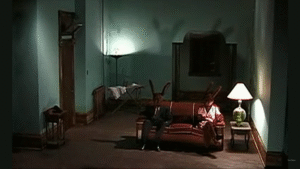 A different sort of rabbit man from David Lynch
A different sort of rabbit man from David LynchJM: The Rabbit Man all comes down to my real-life experience, namely the scene where RB and Adam go hunting. That’s exactly how it happened in real life, and I’ve always carried that. The original concept was completely born out of killing a rabbit wastefully, and what revenge from a supernatural entity might look like. I’m a bit of a pantser though, so as I went, it all grew into something else on its own. The hunger aspect here is sort of a nod to the phenomena of rabbit starvation (which was almost the title!). It’s incredibly lean meat and can’t keep a person going on its own. If all you eat is rabbit, it just isn’t sustainable long-term. It’s really fascinating to look into so I encourage digging that up! The significance of the rabbit to humanity and beyond isn’t something I put much thought into. I can only truly honestly speak from my own perspective, and I tried to keep a narrow focus on that, but if I had to draw one line between them and us, it would be that universal need for companionship, love, safety, and the consequences when that need is denied.
As for comparison, the hunger in IEYH is more about a craving for relief from existential horror, while the hunger in DR is about physical need as a symptom of greater problems, so I sort of look at them as two sides of a coin.
9. Audiobooks. You were kind enough to share audiobooks of It Eats Your Hunger and Dead Rabbit with me. I think I’m weird in that I look at the words as an audiobook reads to me, but doing so increases the enjoyment immeasurably. How do you imagine people generally using your audiobooks, and what do you think is the importance of audiobooks, especially for indie/rising horror authors, in general? Your audiobooks feature Tom Jordan, whose articulation is as crisp as his tones are mellow and soothing (except during moments of character distress, of course). What do you think makes him a good match for these two stories? Do you see yourself doing audiobooks in the future? Why or why not?
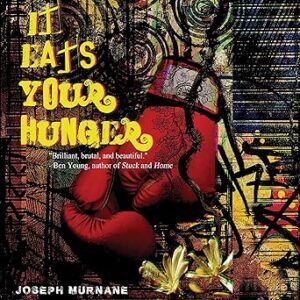
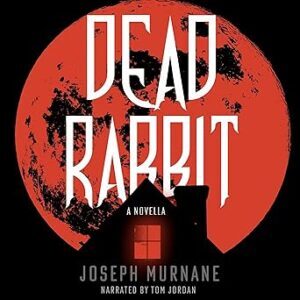
JM: By day, I’m a chef. I work alone, and I listen to audiobooks almost every day. It’s how I keep myself in words when I struggle to pick up a book to physically read. I struggle with depression and anxiety, and sometimes I just can’t connect with physical reading because my thoughts are too scattered. I think audiobooks are so important to accessibility, and without them, I wouldn’t be the reader or writer I am today. Tom specifically just lines up perfectly with my audio goals. I was maybe 10k words into Hunger the first time I heard his work on Andrew Van Wey’s Head Like A Hole, and I just fell in love with it. I wrote the rest of Hunger with him in mind. He really elevates the material in such a way that when I’m listening through and proofing his work, I can’t even believe that I wrote it! Whenever possible, I will always have audio available, and while I have other narrators I plan to work with for specific stories, Michael Crouch and Joe Hempel both high on my list, Tom’s always going to be my default for as long as he’ll have me. Like I said before, I originally didn’t plan on doing an audio for DR due to budget constraints, but Tom read it and actually came to me with an opening in his schedule, asking me if he could produce it at a royalty share rate, so we were able to make a deal.
10. Access! How can readers learn more about you and your works (please provide any links you want to share)?
JM: I distribute through KDP, so my work can be found on Amazon primarily, and is included in KU! I also sell signed copies from my personal shop:
Also, I’m featured in several anthologies. One unannounced that I can’t mention here yet, but Crumpled, organized by Jyl Glenn, as well as another called Phobophobia by Jyl Glenn and Savannah Fischer, which is an exploration of unique fears. That one was released on June 30th.
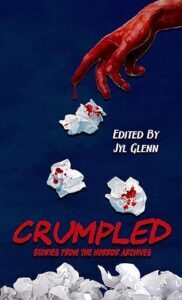
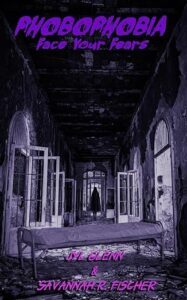
Also keep an eye out, because Jyl and I are partnered up on an Iron Maiden tribute anthology, which we’ve just finalized the TOC on, that will be releasing around October.
On socials, I’m active on Facebook for my main profile and an author profile: Joseph Murnane-Author
IG: 2_Buck_Yuck and joeykoyote4752
TikTok: Joseph.murnane
About the Author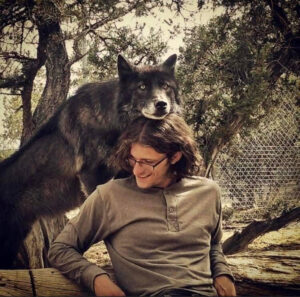
Joseph Murnane lurks at the mouth of a cave off the banks of the Eno River in Durham, North Carolina, with four hellish animal companions and an eldritch queen of terrifying beauty. They say you can see him there just before dawn, but only out of the corner of your eye, and only if he wants to be seen.
The post Interview with Author Joseph Murnane: It Eats Your Hunger and Dead Rabbit appeared first on L. Andrew Cooper's Horrific Scribblings.
June 4, 2025
Interview with Author Ed Downes: Frozen Echoes
Novelist Ed Downes discusses filling his new creation, Frozen Echoes, with horrors of Antarctica touched by several of horror history’s greatest and reflects on what makes the alien really alien–and what might happen if we came across aliens for real.
Frozen EchoesDr. Flint Hill, an Antarctic researcher, has a centuries-old frozen ship burst through the ice near his base.
Dr. Eva Ward, a cultural anthropologist, journeys deep into the Amazon jungle to investigate a strange flute recovered at a dig site.
Hill is overwhelmed when a mysterious duo shows up in a helicopter, followed by the United States Navy, both drawn by a strange signal emitting from the frozen ship.
Back in Sao Paulo, Eva fights off an attacker set on stealing the flute and ending her life, fleeing to a hacker friend to hide.
Aboard the ship, Hill and the Navy discover the remains of a strange creature before the ice closes around them, threatening to end their investigation prematurely.
Eva’s friend takes her prisoner, forcing her to escape and make her way toward the one clue he provided: Antarctica.
Joining forces, Flint and Eva use the Navy’s resources to head under the ice, where they find the frozen echoes of a civilization waiting to be reborn. But is the cost one they’re willing to pay?
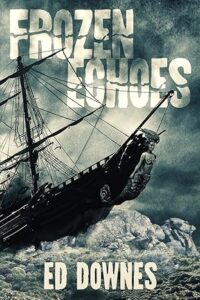 Click the pic for more on Amazon!The Interview
Click the pic for more on Amazon!The Interview1. “Anything weird with the penguins?”: Antarctic Echoes. What inspired you to write a story primarily set in Antarctica? What moods, themes, and images do you like best when surrounding your characters with so much cold, ice, and inhospitable water? While the Antarctic remains a great unknown for most people and relatively unexplored in both reality and fiction, it does appear in two pillars of the horror tradition: Edgar Allan Poe’s underread novel The Narrative of Arthur Pym of Nantucket (1838) and what is probably H.P. Lovecraft’s most influential novel, At the Mountains of Madness (1936). Lovecraft’s work certainly echoes Poe’s. To what extent, if at all, does Frozen Echoes echo either or both of these works? For Lovecraft—and I’d say for Poe as well—there’s something cosmic and horrifying about the sublimity of Antarctica. Do you find Antarctica cosmic and horrifying? Why or why not?
ED: I have always been fascinated by stories that take place in isolation. And I can’t think of any more isolated place on the planet than Antarctica. I grew up watching movies and reading books that depict horrific scenarios set deep in the Arctic ice shelf. Specific examples that come to mind include John Carpenter’s The Thing, which was one of my favorite movies growing up. Another story that sends chills up my spine was an accurate account of an exploration expedition of Sir Ernest Shackleton when he led the Imperial Trans-Antarctic Expedition in 1914. This expedition’s purpose was to embark on a trek across the Antarctic continent. Inevitably, Shackleton’s ship became ice-locked in the Arctic for a long period of time. And the third example that comes to mind is Mary Shelley’s Frankenstein, where the climax takes place in the Arctic, where Victor Frankenstein confronts his creature.
I have always enjoyed reading the works of H. P. Lovecraft and Edgar Allan Poe. I won’t get into either of their personal lives or belief systems. I will just comment on their writing capabilities. Both were very talented in creating stories that instill fear. From the suspenseful horror of Edgar Allan Poe to the immense cosmic horror of H. P. Lovecraft, I have always found myself immersed in their stories. There’s no doubt that both of these prolific authors had an influence on the stories that I want to tell. I’ve always loved the way H. P. Lovecraft can make us feel so small and isolated in his storytelling. His ability to weave a story of dread is still unmatched in my opinion. Also, I have always found Edgar Allan Poe to have a unique talent of building suspense that draws the reader in and makes the story unputdownable.
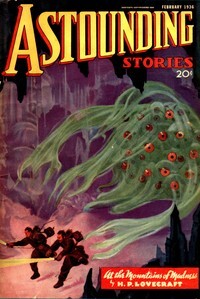 Lovecraft’s classic Antarctic horror
Lovecraft’s classic Antarctic horrorPutting aside for a moment the concept of horror fiction, the mere idea of going to Antarctica gives me anxiety. What I mean is that Antarctica is so far away from civilization and so difficult to travel to and from that going there puts anyone in a highly isolated and vulnerable position. Not to mention, the inhospitable conditions and lack of resources make Antarctica a very high-risk place to visit. That alone to me makes Antarctica a very cosmic place that lends itself to being the fuel of nightmares.
2. Alien Attraction, Alien Horror. A mysterious signal, which your Antarctic scientists think might be a distress signal or could be a warning (like the signal at the beginning of the movie Alien, 1979, another possible influence for you), lures your characters toward discoveries. This initial signal seems to reflect a quality of the idea of the “alien” throughout the book: it is simultaneously too attractive to resist and too horrific to approach. Why the attraction? Why the horror? Why the duality? Without giving too much away, how would you compare your “civilization waiting to be reborn” to other “alien” discoveries? What’s fascinating and terrifying about it?
ED: It’s funny that you bring up the movie Alien. When Alien first hit the movie theaters back in 1979, I was only nine years old. At that time, my parents did not approve of me seeing an R-rated film. So, I could not see Alien for a few years after it came out, and it wasn’t for the lack of trying. I managed to find a book called The Making of Alien, which was a behind-the-scenes coffee table-style book. I drew inspiration from some of the early sketches by HR Giger, whose works of art sparked my imagination to go where it had never gone before. The gothic and ominous nature of his artwork was like nothing I had ever seen. To this day, I find his drawings to be among the most interesting sketches depicting alien life forms and worlds.
Well, eventually I got to see Alien, and it did not disappoint. The pictures in my coffee table book did not do the movie justice. Yes, I had seen the image of the alien bursting through the chest of Kane, played by John Hurt, but seeing it on the big screen in full motion color was a fantastic experience. I still remember the tagline, “In space, no one can hear you scream.”
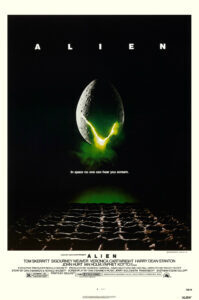
Alien, no doubt, has influenced my storytelling. And there’s something irresistible about a signal coming from a mysterious place. Especially a signal coming from a place where no signal should come from, a place that almost seems impossible. Really, who could resist trying to find out where that signal originated and who sent the signal?
When looking at comparing of my alien civilization born against other alien civilizations depicted in movies, especially the one in Alien, I am reminded that the unfortunate truth is that if and when we do encounter an alien race sometime in the future, it might not go well.
3. Dual Narrative. As the description (above) indicates, your book has two major protagonists, Flint and Eva, and much of the novel has them in separate places and follows them on separate narrative lines, switching back and forth between their experiences and perspectives. Why did you choose this (mostly) dual structure for telling your story? How do you think keeping your main characters apart—and then in key moments bringing them together—shapes the reading experience for your audience? How did it affect the writing experience? Do you expect readers to enjoy both narrative lines equally? Relate to both characters equally? What’s the thinking behind your expectations?
ED: When I was contemplating this story, I struggled with how to create fascinating characters. In doing so, I realized that the two main characters are vastly different from one another. They both contrast with and complement each other at the same time. It made sense to put them in various settings at the beginning to help build them as characters. First, you have Flint, who is older and set in his ways, lives by a code, and has a pretty solid moral compass. Then you contrast that with Eva, who is younger, ambitious, and damaged, but is looking to discover herself and rebuild her life.
Many of the stories I have read and truly enjoyed follow a similar model, where one or more characters embark on their journey in different places or settings and then come together later in the story. I love the storytelling of Clive Cussler, Preston & Child, or James Rollins, as they have a knack for building these types of stories in a fun and engaging way. However, they are in the traditional action-adventure genre. I still thought it might make sense to follow this formula in the sci-fi horror genre.
I hope the readers will enjoy discovering each of these main characters and see the contrast not only in the characters but in the geographies and climates from which they originated at the beginning of the story. The alternating between the two characters in their respective settings at the start of the book creates a pleasant rhythm, shifting from hot to cold. I am interested in seeing how readers embrace each of the characters and learn which ones they like better or dislike, and why. That’ll be a big fun part for me to experience and learn about building interesting characters for future stories.
4. Narrative Authenticity. I see “scuba diving” in your bio (below), but I don’t see anything about diving in the Antarctic… how much research did you do to capture the experiences of living, working, and exploring in Antarctica, both on the surface and in the surrounding waters? Your characters are scientists, an anthropologist, and military personnel: what sort of research did you do when crafting their personalities, determining the sorts of things they would know, and figuring out how they would talk? In short, what did you do to make your characters, settings, and situations feel authentic?
ED: I started scuba diving back in the early 90s and have loved it ever since. My first exposure to scuba diving was in college as a physical education class. Taking this class qualified me for PADI Open Water certification. A few years later, I continued my certification path with PADI Advanced Open Water, Adventure Diver, and Rescue Diver certifications.
Although I’ve never had the opportunity or desire to dive in cold water, such as the icy waters near Antarctica, I could learn about this type of diving. The cold-water technical diving depicted in my story combines elements from cold-water dives and technical dives. Each has special equipment and skill set requirements. For example, cold-water dives require special heated dry suits, and technical dives require specialized equipment and tools for underwater engineering and labor activities. In such equipment, helmets are worn not only to protect the divers from the harsh elements but also to facilitate radio communication between divers. As part of my research, I had to become more familiar with this type of equipment and its applications.
5. Antisocial Academics. Flint, Eva, and other characters have strong ties to the academic world, but to me at least, those ties don’t seem connected to characters’ more admirable traits. Flint is a consummate loner, annoyed by graduate students… Eva once used her academic access for criminal activity… a villain is an academic known for sexually exploiting students… why does ugliness seem to surround academia in your novel? Is the book consciously critical of academia as an “institution?” What about the military, which also seems to be involved in questionable decisions and activities? If—and feel free to tell me I’m off track—the academics and military personnel are tainted by their institutional identities, is there anybody left to model “good?” If so, who and how? If not, why not?
ED: In the context of this novel, the portrayal of academia and the military has a negative tone, aligning with the story’s narrative and supporting the plot. Flint is an old, crotchety researcher living out his last days in isolation, hiding from the world. He has little patience for tolerating nonsense. At the same time, he enjoys working with students and seeing them discover and fall in love with Antarctica.
Eva, on the other hand, is a different type of character. She’s no longer involved with academia, but she still conducts her consulting work in examining antiquities. She has compromised principles and a moral compass that is off-kilter. This is part of her character arc, which changes throughout the story. A big part of Eva’s outlook on life and compromised ethics stems from the negative experience that she had with a former professor who took advantage of her in a personal relationship and then took credit for her work, all while tarnishing her reputation in academia.
As far as the Navy goes, they are just doing their job in following the mysterious signal coming from under the ice. That irresistible signal that we talked about earlier is so enticing that it can’t be ignored. That and the Navy’s need for security and secrecy as they explore and discover the national security implications of the signal source.
6. “A little lady named Pandora.”: The Ethics of Exploration. On a related note, from the moment the scientists decide to investigate the signal that could lead to something dangerous for them and perhaps for humanity, the impulse to explore and solve mysteries comes into question. Like Mary Shelley’s Frankenstein (1818), a book that begins and ends with polar exploration, does your novel question the ethics of exploration? Does Flint’s ambition to garner achievements like Shackleton stem from a character flaw? Why or why not? Knowing that gaining access to the echoes of the civilization beneath the ice might be like opening Pandora’s box, do your characters have a moral and/or ethical duty to step away? Why or why not?
ED: It’s like most scientists to be curious about discoveries. In many cases, this desire to discover can be reckless and dangerous. From the beginning of the story, various elements reveal this curiosity. We see students arriving to learn and do research. We see Flint working in the weather station, and we get a glimpse into Flint’s personality and character. Then, with the helicopter crash. And the curiosity surrounding the signal emanating from a mile below the ice.
It truly is a Pandora’s box. And a slippery slope as the scientists and the Navy don’t see what’s coming, and they slowly slip closer and closer into the danger zone as they become more aware of what is going on. I don’t want to reveal any plot details that would spoil the story for the reader.
Interestingly, you ask about Flint’s motivations compared to Shackleton’s. I see your point that some of his actions could be driven from a place of scientific ambition and therefore recklessness. I view Flint as a highly ethical scientist who consistently strives to do the right thing. This can be challenging to balance against the ambitions of scientific discovery. I think in an ideal world, the scientists and the Navy would have a moral and ethical obligation to step away from the dangers to humanity as soon as they realize them. I also believe that a combination of human curiosity and scientific ambition makes it almost impossible for the characters in this story. They cannot avoid Pandora’s box, no matter the cost.
7. Alienness. Although I don’t want to give away too much, your characters do find something “alien,” and your book provides detailed descriptions of alien places and things. Start with the flute: why did you decide to make sound integral to the alien technology? What, in your imagination, helps make technology seem alien? Similarly, you deal with forms of connectedness and communication that are alien to human experience, based more on a “hive” model. Why turn to the “hive” for a sense of alien interconnectedness? You describe alien architecture. What shapes and structures strike you as alien, and why? Eventually, your story calls for narration from the perspective of someone having an alien experience, i.e. going through something humans couldn’t normally feel or perceive. How did you manage that?
ED: Yes! Let’s not give away too much lol. But to answer your question, I’ve always had a fascination with exploring alien worlds and what that might look like. I’ve also contemplated various questions about what alien technology might look like or feel like for humans at length. It’s all an exercise in imagination, but in the world that I painted here in this story, I see the alien species as seeking a parasitic existence with humankind.
One of the plot elements that I was looking to engineer for my story was some sort of artifact that would be the catalyst for Eva to become part of the story. This artifact also had to hold significant meaning in the latter part of the story. All the while, it contributes to the ticking clock through its exposure to the surrounding people. And I’ve always wondered what a flute might sound like if it’s played underwater, and what could that mean, or what could that do? So that’s what I built into the story.
The technology depicted in this story had organic and biomechanical foundations. Materials, tools, and equipment are bio-engineered organically rather than manufactured. It almost had a similar look and feel to H.R. Giger’s concepts from Alien. This type of technology is so foreign to humans that it lends itself to creating more tension in the story and emphasizing the contrast between the human world and the alien world. I think this also can make the reader a little uncomfortable, which contributes to the reading experience.
In thinking about the species of beings encountered by the researchers, I wanted them to be a kind of like the Borg from Star Trek, but my version of that hive mind. I’ve always been a little freaked out by body horror in mutation, so it seemed like a natural direction for me to go in. Because if I’m a little freaked out writing it, I’m sure people are going to be a little freaked out reading it.
As the story progresses, we hear the viewpoint of a human going through a transformation and becoming part of this new species. It brings to mind elements from the movie The Fly. Humans can comprehend and articulate what is going on inside of them. I think this makes the story more relatable and personal for the reader, creating more tension and fear of loss as it progresses.
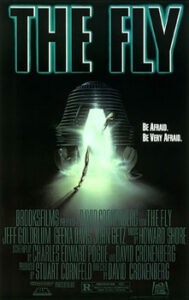
8. Unpredictable Bodies. Early in the novel, characters learn that exposure to the alien artifacts and structures affects human bodies, leading to death for some and odd changes for others. The term “body horror” has been popular lately: did you write the changing bodies in Frozen Echoes with “body horror” in mind? What do you think of “body horror?” Another work of Antarctic alien horror that might be an influence, John Carpenter’s film The Thing (1982), predates the term’s popularity but qualifies as a masterwork of body horror—to what extent might it have influenced you? Why do you think “body horror” is enjoying a spike of interest for horror’s readers and viewers today? Not all of the physical changes your characters experience are necessarily bad… is an unpredictable, alien, physical transformation ever not horror? Why or why not?
ED: The alien artifact, specifically the flute, was an integral part of the story—almost a nonplayer character, so to speak. I touched on it in a previous question, but let’s go deeper into what’s going on behind the scenes with the flute. Exposure to the energy emanating from the flute has adverse effects on the human body, killing some people and altering others. This is coming from a place of body horror. It’s also a contribution to the ticking clock and helps to establish the stakes at the beginning of the story.
It’s funny that we come back to John Carpenter’s The Thing. Undoubtedly one of my favorite movies of all time and highly influential in my writing. A combination of the isolated setting and the body mutations that take place through exposure to the alien being.
In recent years, we’ve seen an uptick in body horror, I think, and I’m not sure where it’s stemming from, but people seem to love it. Body horror, as I mentioned earlier, has always freaked me out. I think the reason it’s so bothersome to me is that there are changes that the human body undergoes in some situations that there’s no coming back from. One movie I saw recently was called Tusk. That movie gave me nightmares, and I just kept saying to myself, “Well, there’s no coming back from that!”
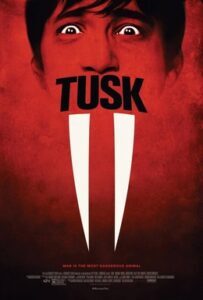
As you mentioned, not all the physical changes that the characters undergo in this story are bad; a prime example of that is Flint. At the beginning of the story, we see his struggle with his arthritis and his raw hands and the difficulties they create for him in just functioning daily. This is contrasted by the version of Flint at the end of the story, where he has completely changed, and those shortcomings are no longer present, although they are replaced by changes that might not be seen as positive. But I’ll leave that for the reader to decide.
9. Proof? I’m not saying what characters do or don’t discover—and I’m not saying whether your characters or even the planet survives—but I will say that questions arise about what might happen if scientists discovered proof positive of intelligent (even superior) alien life. What do you think: if a team like the one in your novel managed to reveal proof of an intelligent alien species, how would the world react? How would the world change? How much and what kind(s) of proof would scientists need to be generally believed? Would people tend to assume that such a species poses a threat? Why or why not? Do you think the existence of such a species would likely be a threat? Why or why not?
ED: I touched on this briefly in the earlier part of the interview, but I’m glad you brought it up again. There is intelligent life in the universe that humankind will come into contact with in the future. The universe is a big place, and it’s just a matter of time. It sparks the question of what that would look like. And why haven’t we experienced an interaction so far?
An interaction with an alien species could go in many directions. Humans, by nature, are predisposed to fear what they don’t understand and, therefore, would most likely default to a defensive or offensive posture. This could easily lead to violence and either the killing of the alien species or the eradication of humanity.
When asked why we haven’t experienced an interaction with another race in the universe, there are infinite possibilities. There is a concept known as the Fermi Paradox, which is a contradiction between the high probability of extraterrestrial intelligence existing in the universe and the lack of evidence for such civilizations. There are a few theories that speculate on why this might be the case. Now, given the size of the universe, there’s a high probability that life exists beyond our own. And despite decades of searching and monitoring, we still have found nothing. At least nothing that the government has shared with us.
Possible explanations include the Great Filter, a barrier that prevents intelligent life from reaching a particular stage of development. Self-destruction, that’s self-explanatory. Too far away. Unrecognized signals. Or the one that scares me the most, the dark forest, which suggests that advanced civilizations are deliberately hiding to avoid destruction. There could be alien species that are close by, equivalent to or superior to our technology, and choose to remain anonymous because they’re aware of humankind’s violent nature.
It’s also possible that we’re just plain old lucky that the wrong alien species hasn’t noticed us yet. In other words, the species that would see us as a threat that has far superior technology and is willing, able, and ready to wipe us out. That’s the worst-case scenario.
10. Access! How can readers learn more about you and your works (please provide any links you want to share)?
ED: Sure, I would love to hear from my readers. Feel free to reach out to me on my website www.eddownes.com. You can also find me on Facebook, Instagram, and other social platforms. And if you enjoyed the story, please consider posting a review or sending me a selfie of you holding my book so that I can add it to my website. Pictures of my happy readers are little trophies for me, and that’s what keeps me writing!
About the Author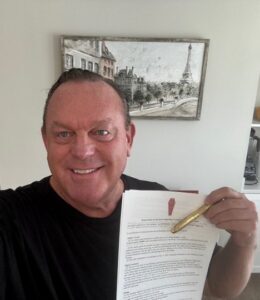
Ed Downes writes stories that are suspenseful, sometimes scary, and always thrilling, where things are not always what they seem. His entertaining yet vulnerable characters usually find themselves thrust into situations that appear to be no win. Ed is the author of many short thriller fiction stories including “Qalupalik,” “Regrets,” and “Dr. Bonz.“ He has recently completed his Master of Fine Arts degree in Writing Popular Fiction from Seton Hill University. A publishing industry marketing strategist by day, and novelist by night, he is a Boston native, and a lover of tennis, skiing, and scuba diving.
He currently lives in Raleigh, NC, most likely reading or writing thriller fiction or doing fun stuff with his wife Jeanie and two daughters Melissa and Jessica.
The post Interview with Author Ed Downes: Frozen Echoes appeared first on L. Andrew Cooper's Horrific Scribblings.
May 21, 2025
Interview with Author JG Faherty: The Malthusian Correction and The Nightmare People
Almost two years since our last interview, accomplished author JG Faherty checks in to discuss two horror novellas, The Malthusian Correction and The Nightmare People, both on the edge of release, very different stories but both stunning–enjoy the insights!
The Malthusian Correction (available May 27, 2025!)When Roger Brenner leaves the house because he has the urge to take a walk, no one, not even him, realizes he is about to change the world as we know it.
Roger’s sudden desire quickly turns into something more as both his mind and body begin to change. He is consumed by his need to keep walking, and soon he is leaving the small town of Rocky Point behind. By the time his family realizes he’s gone, he’s miles away and entering an altered state of consciousness.
As the days go by and Roger continues his unnatural journey, his body begins to deteriorate. He also attracts followers, all of them murmuring the same chilling phrases: “Walking” and “Must keep walking.” The growing horde travels down the East Coast, getting larger every day, with more and more of the walkers devolving into shambling, undead creatures. In less than a week, the phenomenon spreads across the world, causing religious and political upheaval. The governments fear it’s a disease. Religious leaders claim it’s a sign of the apocalypse. And scientists say it’s nature correcting overpopulation.
The same questions plague all of them:
When will it end?
And what happens next?
The world is about to find out.
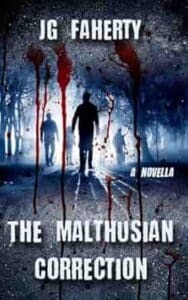 Click the pic for more on Amazon!
The Nightmare People
(available June 10, 2025!)
Click the pic for more on Amazon!
The Nightmare People
(available June 10, 2025!)Forty years ago, rookie cop Bill Furman pursued suspected serial killer Arthur Blanke into the basement of Blanke’s house and witnessed something that has given him nightmares his entire life.
Blanke turning into a demon and disappearing from a locked room.
Now Furman is Chief of Police, and gruesome murders are once again rocking the small town of Moonrise Cove in North Carolina. Children and their parents torn to pieces. Other children missing. The crimes are eerily similar to the ones Arthur Blanke committed. But they also seem to have something to do with Allison Navarro’s family. Furman is aware Allison and her children survived an attack by a similar serial killer in Rocky Point, New York, twenty-five years ago. His suspicions about her family’s involvement grow stronger when Allison’s estranged son, Ken, is arrested at one of the murder scenes telling tales of a Japanese demon, the oni, being responsible.
Furman’s life is turned upside down when he and Ken come face to face with the demon and he learns that it’s been responsible not just for the deaths in Moonrise Cove and Rocky Point, but for hundreds, perhaps thousands, of deaths around the world. Because the oni is the Boogeyman of legend.
And it’s out to finish the game it started decades ago.
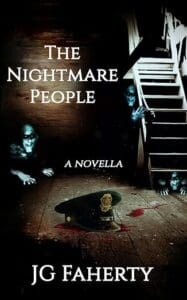 The Interview
The InterviewThe Malthusian Correction
1. The Malthusian. The description of The Malthusian Correction (above) overstates the unity of scientific opinion in your book, but one character does refer to population correction and the theories of the eighteenth-century political economist Reverend Thomas Malthus, named in your title. I’m only familiar with Malthus because of a very weird course I took in college. How did you come across his thinking? What gave you the idea of exploring his ideas in horror fiction? Did Malthusian thinking spark the idea for the novella, or did its inclusion come later? Either way, how did this unusual storyline take shape in your mind? To some, Malthus’s ideas might seem a little crazy… but he was a legitimate forerunner of Darwin, whom history takes much more seriously. Do you think there might be any validity to the idea that nature could “correct” overpopulation through its own devices? Why or why not?
JG: I was a biology major the latter half of my college years and also in grad school. One of the classes I took involved population modeling for an ecosystem, and we briefly touched on Malthus’s theories as they related to biological systems—like what you see in rodent populations when things get too crowded, or when predator-prey numbers get out of whack. Of course, that was 40 years ago, so I had to go back and look up some of the details to make sure I remembered things correctly.
The idea for the story didn’t come from that, though—that came from me reading the news and seeing all sorts of stories about plane crashes, wars, rising murder rates, etc., and wondering “what if all of this, the death tolls, the rising hatred and frustration we see in social media, the so-called ‘accidents,’ was really just the result of us over-populating the world? In nature, when one species gets out of control, some kind of check always balances it out. Either predator numbers increase, or the species consumes all its food sources, and starvation thins the herd. In rodents, especially mice and rats, if there are too many in a closed system (like a cage), they begin to murder and even cannibalize each other. Heck, even primate troops resort to violence when things get crowded, either killing or driving out members of the tribe.
So, once I had my plot, it was simply a matter of figuring out the basics: what tone did I want (scary, weird, action-oriented), what kind of correction would it be, and what was the outcome. And the answer came to me almost immediately. Lemmings. Now, we know that in real life, the whole idea of lemmings committing mass suicide is not really a thing. But it was perfect for my story, and since lemming suicide isn’t real, I needed a different scientific explanation. And that’s where natural correction came in, and from that the side-track of Malthus, and from that both the tone (weird) and the title.
It sounds like a lot, but I needed probably all of ten minutes to think of the plot once the idea appeared and another ten to look up the Malthus information to make sure I remembered it correctly.
As for my premise being true (nature correcting overpopulation), who knows? I do believe that overcrowding leads to violence and anger and stress. I think it’s why you see more violent crime in cities than in suburbs or the country. The more people you have jammed together, the higher the stress levels and the shorter the tempers. And in a way, rising grocery prices are the modern equivalent of natural resource shortages. Look what happens when there are empty shelves in the stores. People instantly turn feral. Most of us are one bad month, socio-economically, from going full lizard-brain.
The real question becomes, is there an overall driving force behind all this—God, Mother Nature, some higher power or almighty entity—or is it just how all things are hardwired at the most basic genetic levels? That any species will inherently do the same things in a similar situation because that’s simply how it has to be for nature to work properly?
I actually have a couple of short stories that explore this from different angles, which I hope will see the light of day (publication) in the near future.
——————
2. The Surreal. When Roger’s wife tries to communicate with him during an early phase of his walk, she experiences the interaction as “like a dream. Or an acid trip.” Readers know Roger feels “purpose” in walking, but the nature of that purpose—the motivation behind his and others’ bizarre, self-destructive behavior—remains obscure, making me feel like Roger’s wife does during that early moment through much of the story. Did you set out to create a surreal reading experience? If so, why, and what aspects other than the walkers’ bizarre behaviors contribute to the surreality? Either way, what do you think “acid trip” moments contribute to the story’s horrific impact? What does the bizarreness of what’s happening do to people in the world of the story, and what do you expect it to do to people reading the story?
JG: I absolutely wanted the entire story to feel surreal, but not in a Twilight Zone way. I was going for weird. Keep the reader guessing to the very end, yet with a few clues scattered around. I didn’t want “scary.” Not in the usual sense. In order to do that, and to make sure neither Roger’s wife nor the authorities could stop him and his followers, I had to create something that was somewhere between zombie and fanatic. One of the examples I use in the story is when Roger’s lawyer reminds people that no one blinks an eye when someone wants to walk across the US for charity or swim the English Channel or do other crazy-sounding stuff. But I also needed Roger not to be “normal” anymore. Is it a disease? Has he been taken over by a higher power? Obviously, something supernatural is at play, as we see throughout the story’s progression. But it’s slow, and by the time people realize it, the whole phenomenon is in full force.
In a way, this is an offshoot of a non-zombie, non-apocalyptic zombie apocalypse novella I wrote (along with a follow-up short story) a few years ago. It’s called December Soul (the short story is “The Lazarus Effect”). Both are in my collection Houses of the Unholy, and they describe how a growing segment of the population suddenly stops eating, stops speaking, and just starts gathering in large groups. Wherever those groups appear, more people become like them and join them. No one knows why. No one can explain how they don’t starve to death or die. But as more and more of them happen, suddenly society is in trouble because it’s breaking down. All these peaceful people just standing around or walking in big groups through the streets and parks and neighborhoods. I won’t give away the ending, but it turns out to be something other than what it seems to be.
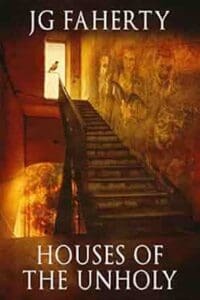
That was another part of The Malthusian Correction that I enjoyed exploring. The idea of zombies that didn’t eat brains, weren’t violent, weren’t really zombies except that they were dead and still walking.
My hope for this story is two-fold. One, that readers are entertained. And two, after they experience the thrills and chills of the story, the chills part sticks with them and comes back each time they read the news about another plane crash or mass murder.
——————
3. Voyeuristic Frenzy. You provide a fair bit of information about the media response to the walker phenomenon, and some media representatives seem to try to prolong the phenomenon because it gets good ratings. Are you critiquing how media outlets tend to respond to unusual and potentially tragic events? Showing what you think would be a realistic response to such events? Both? What about people who come to watch the walkers as their numbers grow—does your book judge their voyeuristic curiosity? Why or why not? What’s significant about the desires to see and to know that you portray? How do they relate to your readers’ desire to “see” and know more as they read along?
JG: I think it’s a pretty realistic representation of how we’ve seen both media and onlookers react to tragic and tumultuous events. Would the media exploit something like this? Absolutely! Look at coverage for everything from storms (often blown out of proportion for days in advance), wars, politics, everything. It’s 100% about ratings now, and scooping the competition, and keeping people glued to their TVs, phones, etc. There is no journalistic integrity anymore, and even if a reporter had some, the station would either poison it or fire them.
As for the people—there would definitely be hordes of onlookers. People come from miles away to see anything unusual. Dead whale on the beach? Let’s go! Brush fires in the hills? Let’s drive past and see them. Sinkhole opens up? Plane crashes in the woods? Gotta check it out! It’s simple curiosity, and in some folks it overrides common sense. You’ve seen them. The ones that have to get right to the very edge of the Grand Canyon, where one wrong step sends them over the edge, just for the perfect selfie. The ones who stand and watch while a crime is being committed, like a bank robbery or a hostage situation, all of them right up to the edge of the police barriers. Do I think people would come watch dead people marching through town, even at the risk of becoming one? Yes, I do.
Does that relate to readers wanting to keep going with the book? No, I don’t think so. One is voyeuristic curiosity; the other is being caught up in an interesting story. Although I guess an argument could be made that the onlookers are there because in a way they’re being entertained.
——————
4. Religious Frenzy. When Roger’s wife tries to stop his walking legally on mental health grounds—he may be a danger to himself or others—people object for various reasons, particularly because he has a right to go on a religious pilgrimage even if doing so is detrimental to his health. Why are people so quick to ascribe religious significance to his seemingly inexplicable behavior? As more people join the walk, religion and public health concerns come more and more into open conflict. To what extent did similar conflicts over vaccination, particularly during the COVID crisis, influence your representation of this conflict? Does your book take a position? Why or why not? Caring for the mental health of walkers seems to be especially at odds with religious aims. How does this conflict resonate with what you see in the world outside your fiction?
JG: One of the things I’ve found about my writing is that rarely are the underlying themes or subthemes—in this case, religion vs. science, religion vs. politics, politics vs. science, etc.—part of what I have in mind when I start writing. Often, I don’t even catch them until after I’m going back to edit, or, in some cases, when reviewers mention them. That was a huge shock for me when I wrote my very first novella (The Cold Spot) back in 2012 (wow, so long ago!). In that book, I came up with the title because the main character, a kid who’d been bullied because of a birthmark on his face, discovers a cold spot in a cemetery that is from the presence of ghosts. It was only later, when a reviewer pointed things out, that I realized the title had multiple meanings. The boy’s birthmark (he’s cruelly nicknamed Spot) has turned him emotionally cold. And he’s placed in situations where the people (and ghosts) closest to him end up doing terrible things (he is in cold, hard environments).
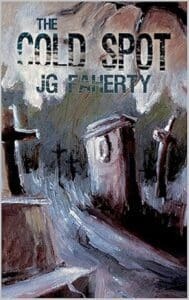
A similar thing happened with The Malthusian Correction. I definitely wanted there to be some involvement with religious groups. How could there not be? Once it’s shown that Roger and his followers are dead but not-dead, and especially after the one scene where they should all be dead but they “return,” it’s like events from different religious tales are occurring in real life. Is it a second coming? Is Roger Jesus? Is it the apocalypse? Or, as some of the atheists and scientists proclaim, does it mean that there is no heaven, no hell, that non-death, or after-death, is simply another state of being? Do the dead have souls, or are they simply automatons?
Religious groups would be arguing like crazy. And, again reverting back to basic human nature, new religions would spring up. Humans are nothing if not predictable.
On the other hand, when it came to the health aspects of the situation (dead people marching through towns, possibly carrying deadly diseases), I had no thoughts about COVID as a key plot point. I simply went with what I thought would be a standard healthcare and military reaction to a situation like that. I’ve worked in the biological sciences, including some time working with infectious diseases, and I have friends who are virologists and bio-geneticists. Who’ve worked at the CDC or NIH. I didn’t want this book to be a statement about COVID; however, there were obviously some basic parallels because even if COVID never happened, a situation like this would still require an epidemic/pandemic-type of response at some point. Those procedures were always in place; COVID simply made more people aware of them.
——————
5. The Walking Dead. The description of your book mentions the walkers becoming “undead.” I’ll venture that it’s atypical, but how is and isn’t The Malthusian Correction a zombie story? You give Jonathan Maberry and Brian Keene cameo appearances and mention other horror along the way—what works were your major influences? Did you set out to write a fresh take on the zombie? If so, why do we need a new zombie for 2025? If not, even though the Z word is one of many conceptual frameworks people use to try to explain your walkers, how are your walkers not zombies? Why would and/or wouldn’t you want to put The Malthusian Correction in the zombie subgenre?
JG: I’ve written a lot of zombie stories, despite the fact that I don’t typically enjoy zombie stories (or movies, or TV shows). The reason I don’t usually enjoy them is they are so predictable. Slow moving zombies take over the town, or the world, or whatever. Fast moving zombies take over the town or the world, or whatever. People have to band together to stop them. Keene’s zombies were a bit different because some of them could think. Maberry’s zombie books are good in large part because he focuses more on the people than the zombies, making the terrors more realistic. But stuff like The Walking Dead, man, that gets old real fast. That series should’ve stopped after Season 3. Same with The Last of Us – it’s already reaching the point where it’s right back to the overused “warring communities” plot. (I can’t comment on either of the comic series because I don’t read comics much and haven’t since the mid-90s.)
What happens with me is that when I come up with a zombie-type story, I immediately throw it out unless it happens to take the genre in a very different direction. For instance, in “Home on the Range,” zombies are trainable and can be used as day labor and illegally as sex workers. In “Family First,” a man succumbs to a zombie bite and then wakes up to find that as long as he eats brains, he can remain a normal, fully functioning rational person, and now he has to rescue his family before the zombies get them—except the effects of brain eating only last a few hours. In “Marshal Law,” the reanimated corpses have an agenda, which you can guess from the title. In “Street Action,” zombies are part of society but there is a serious prejudice against them, and one decides to rebel. Most recently, “Mezzamort” is featured in the GabaGhoul anthology, with warring zombie mobsters as the heart of the plot.
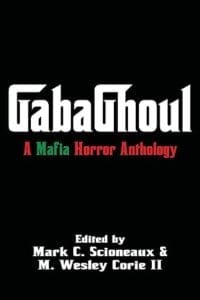
I love taking the idea of the zombie and turning it around, twisting it into new shapes, making it something it’s not. So, as I wrote The Malthusian Correction, I consciously made sure it wouldn’t be a Walking Dead knock-off. Are Roger and his followers zombies? I guess that depends on your definition. At some point, they are dead. And they still move. If the definition of a zombie is that, then yes. But then vampires, mummies, ghouls, Frankenstein’s monster, and lots of other scary creatures would be zombies. Roger et. al. don’t eat flesh. Don’t kill anyone. Haven’t emerged from graves.
Would I put it in the zombie subgenre? Maybe, in the broadest sense.
Do we need a new zombie for 2025? Probably, and probably not. Unlike me, a lot—a real lot!—of people enjoy the tried-and-true zombies. So I think you could maybe have a new kind of zombie, but it would be in addition to the classic ones, rather than replacing them.
——————
The Nightmare People
6. Nightmare Influences. References to serial killers run through The Nightmare People. On the one hand, serial killers are a rationalization of the demonic, but on the other—are serial killers the kernel of your monster’s horror? A real serial killer, John Wayne Gacy., who killed children, gets mentioned at least once, and a fictional serial killer who kills children, Freddy Krueger, gets mentioned at least twice. In his movies, Freddy gets called “the boogeyman” and is certainly a nightmare person—how do real-life child-killing nightmare people, movie-spawned child-killing nightmare people, and your child-killing boogeyman relate? Your novella also mentions Stranger Things, a TV show in which entities from another realm repeatedly threaten kids. Your story alludes to another realm, and “Nightmare People” might refer to characters having nightmares as well as “people” monstrous enough to inspire nightmares—would you place your novella in a cluster with serial killer stories, Nightmare on Elm Street, and Stranger Things (perhaps with the horror turned up to eleven)? Why or why not?
JG: Wow, that’s a lot to unpack! Like I mentioned above, I don’t usually think about that deep stuff when I’m writing, at least not consciously. I think, for my thought process, it was more basic. If the boogeyman really did exist, it (or they) would be considered the most outrageous and prolific serial killer(s) / psychopath(s) in history. Frightening children. Stealing them. Killing them. Depending on which legend you examine, the boogeyman (or equivalent) is pretty awful.
With that in mind, I had to look at it from a cop’s point of view (because in book 1 of the trilogy, The Nightmare Man, a cop was one of the main characters, and that continues into books 2 and 3). No cop is going to believe in a supernatural serial killer. Heck, my two cops don’t, and they’ve both encountered the boogeyman! In these books, the cops do what most people would: try to rationalize what’s happening. The pop culture references, like Freddy Kreuger or John Wayne Gacy, I threw in because I think people would talk about them in conversation. The cops I know certainly would. And the manner of the deaths—the bodies being sliced up, chopped up—is reminiscent enough of horror movies to make those comparisons logical.
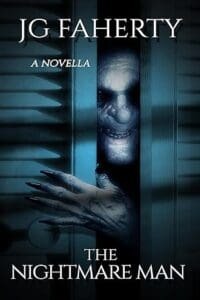
Imagine you’re in a dimly lit room and you see this tall, monstrous thing with long claws butcher someone. All adults know monsters don’t exist. So there’d very quickly be rationalizations. Man in a gorilla suit. Man with home-made Freddy Kreuger knife-gloves. Eventually, our heroes come to accept that there is no rational explanation except that the kids in the story are right: it’s the boogeyman. But without having seen it themselves, many of the adults, including FBI agents, learn the lesson too late.
I suppose that someone somewhere has done psychological studies about serial killers of children, people who think they’re the boogeyman, who were scarred as little kids by those stories or by being victims of serial killers or whatever. My books aren’t the place for that. I think if you start going that deep with what is essentially a horror thriller, you steal some of the inherent fear from it and it becomes more of a study object than entertainment.
I just wanted my cops to act like cops, my kids to act like kids. To be scared. To be wrong.
As for where I’d place this in the genre, I think I’d shy away from calling it a serial killer book. Sure, the boogeyman is a serial killer in the strictest definition, but then so would be Dracula. The Mummy. Any monster with a list of targets to kill. That would make my mummy novel Ragman a serial killer book, too! It’s a police procedural just like the Nightmare World trilogy. Maybe that’s the best description: Supernatural Police Procedural.
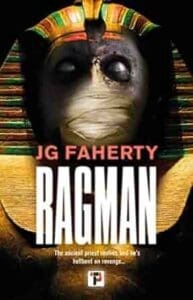 Mummy with a mission!
Mummy with a mission!——————
7. Nightmare Images, International Boogeymen. This novella is gory, and a lot of the flying body parts belong to kids. Do you feel that it’s risky? Why did you decide to be so explicit? Even though the U.S. has come a long way in terms of what it will allow onscreen, I imagine a film adaptation would tone it down a bit… but as the description (above) indicates, your monster is global, so a film adaptation wouldn’t have to come from the U.S. The “oni” is Japanese: does your rather extreme monster have any relation to Japan’s historically more extreme horror cinema (the works of Hisayasa Sato and Takashi Miike, for example)? Even if it doesn’t, for your mostly American characters, does the oni’s foreign dimension increase the terror it inspires (the only thing Japanese most of them seem to know is Godzilla, mentioned twice)? Ultimately, how does your monster’s global reach affect its grisliness?
JG: Well, I don’t imagine there’ll ever be a movie made from this trilogy! Like you said, chopping up dozens of kids isn’t what most moviegoers are looking for. What made me be so explicit was I never had any intention of pitching this trilogy to a Big 5 publishing house. I knew as soon as I started writing that it would be a little gorier than what I normally do (but let’s be honest—it’s not “extreme horror” gory; it’s not Human Centipede gross or even Texas Chainsaw Massacre bloody; however, it’s kids, so….) and that it would either be something for the small press or to self-publish. Luckily, Lycan Valley Press liked it and agreed to do all three books.
It’s funny that you mention Japanese horror. It was the oni legend, through the game of hitori kakurenbo, that crystallized the plot for me. I had this real vague idea about a boogeyman who follows a boy from childhood to adulthood, but I didn’t want to do the US version of the boogeyman because it’s so familiar. So I started googling boogeyman legends, and I came across the Japanese one and also the Puerto Rican one (the cuco). That’s when I had the idea that two different people could be haunted by the same monster, and if they somehow came together… So, in order to do that, I had to have Ken play the hitori kakurenbo game as a little boy, call forth the oni, and set everything in motion.
And here’s a little secret: Aside from the Godzilla universe movies and a couple of other films (Ringu, Dark Water) I’ve not seen much Japanese horror, and I can’t stand anime or manga; in fact, the inclusion of that type of drawing is what made me stop reading Marvel comics in the 90s. So that style of horror had zero influence on these books. I simply chose a Japanese setting to start the trilogy because it made the best sense as a plot initiator.
——————
8. Monster! When they see your monster, several characters shout, “Monster!” Encountering it seems to make knowing it is a monster almost instantaneous and inevitable. This thing isn’t Frankenstein’s sympathetic Creature. There’s no doubting this thing is bad news. What allows characters to recognize the creature’s undeniable badness? You emphasize sensory details. Why the glowing red eye? What aspects of size and shape make the monstrous? Why the animal features—hair, teeth, claws? What about sounds? Why so much emphasis on smell, and why the specific smells? To sum up with a big word, what’s the key to your epistemology of monstrosity?
JG: The thing about horror is, when you start writing about monsters, how can you create something new yet familiar? How do you describe something that everyone knows, and yet still make it scary? Conversely, how do you describe something no one’s ever seen before and make it scary without going overboard on details?
This was my conundrum for the boogeyman creatures in The Nightmare Man, The Nightmare People, and, preparing for line edits as we speak, the final book in the trilogy, The Nightmare World. In the US, the boogeyman is described in all sorts of different ways. But one of the nice things about the Japanese oni and the Hispanic cuco is that they actually look similar. Big, ogre-like or Bigfoot-like creatures, hairy and toothy and really mean. To that I added my own details: red eyes (yes, it’s been done a lot, but I wanted them very visible in the dark) and an awful smell. I mean, think about it. All those fables and bedtime stories about boogeymen, but none of them go beyond how they look and maybe that they whisper or growl.
They’re monsters. Monsters that live on human flesh and carve people into pieces. Meaning they have to get covered in gore. And you know they aren’t showering when they get home. They should stink really bad. I tweaked that a little to add the fart smell. Why not make them stink as bad as they look? Plus, smell is a great way to foreshadow the appearance of one, or realize one has been there in the aftermath of a murder.
There’s also this: any good writer or editor will tell you that a story should encompass as many senses as possible, not just vision. It helps immerse the reader in the story.
The reason for the claws: gotta slice them bodies up somehow.
The reason for the teeth: gotta eat that flesh, plus they’re scary looking.
Nice thing about a monster is that I can create a whole race of boogeyman creatures, and they can be different from everyone else’s, but it’s still right, because there is no wrong.
The one thing I try to do, though, with all my monsters, is make them believable. Sometimes a monster can be so “out there” that it becomes laughable. I don’t want that. I create my monsters—whether they be boogeymen, Lovecraftian beings, mummies, ghosts, were-creatures, zombies, Krampus, etc.—with a healthy mix of legend and scientific possibility. Not probability, but they pretty much adhere to the natural laws of physics and somewhat with the laws of nature and biology. Although I have no problem stretching those!
The last thing I want is someone reading one of my books and thinking, “that monster is stupid.”
I want them to say, “oh, hell, this almost seems like it could happen.”
——————
9. Big World-Building, Short Book. You do so gracefully, but you squeeze a lot of world-building into this short book, developing not only a significant cast of regular people but also a monster associated with deep lore and a realm you merely sketch. What’s the personality of Moonrise Cove? Without giving too much away, what sorts of things can readers expect to learn about the demonic oni and its realm? With all the world-building you’ve done, do you expect to revisit some of this material—might there be more from the realms of The Nightmare People?
JG: From the minute I came up with the idea for The Nightmare Man, I knew it would be a trilogy of novellas. The way it was structured in my head and in my first outline wouldn’t work with a single novel, even if that novel went 120,000 words. Too many ups and downs in terms of climaxes.
And I saw everything clear as day. Book 1 (The Nightmare Man) would set everything in motion. Two of the three key characters (Ken, Rob) and their family, and the history of the oni/cuco in their lives. Book 2 (The Nightmare People) springs us both forward and backward in time, as we meet Chief Furman and find out his involvement with the boogeyman and set up the intersection with him and Ken’s family. Book 3 (The Nightmare World) will take us back to that place where Rob and his daughter visited, the alternate reality where the boogeymen come from.
At the same time, the titles show how the cast and stakes grow larger: Nightmare Man represents both the oni/cuco and Ken or Rob. Nightmare People gives us several more characters dealing with the demons. And Nightmare World will not only take us across the divide, but it also represents how bad the situation in Moonrise Cove has become.
Nightmare Man takes place in the fictional town of Rocky Point in upstate NY. When I wrote it, that’s where I lived (it’s based on a combination of two towns, Stony Point and Haverstraw) and where a lot of my books and stories have been set. When I moved to North Carolina in 2024, I created the fictional town of Moonrise Cove, which is situated between and above Wilmington and Leland. The next question is going to be why do that, and my answer is, I like writing about the areas where I live. Especially small towns. You can work in so many tiny details that make a story more authentic.
And I won’t lie, it comes in handy when the local library or bookstore is looking for a “local author” for an event or if you want to sell your books locally and you can say “takes place right here in town!”
Of course, I’ve also written about places I’ve visited a lot (Ragman is set in NYC, Hellrider is set in the Everglades of Florida) or previously lived (upstate NY, the town of Olean, where I was born and went to college, is the basis for my town of Hastings Mills and the setting for books such as The Wakening and The Burning Time), and also places I’ve never been. But sooner or later, I end up writing about “home” again.
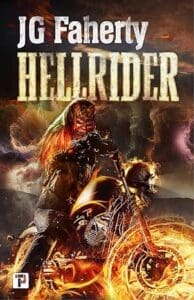
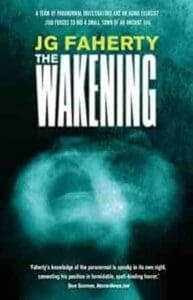
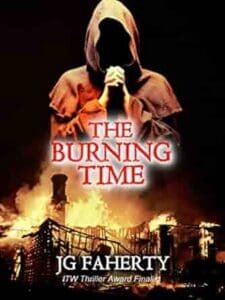
——————
10. Access! How can readers learn more about you and your works (please provide any links you want to share)?
JG: Well, the easiest way to keep up with me and what’s going on is to visit either my website (www.jgfaherty.com) or my Facebook page (www.facebook.com/jgfaherty). I’m also semi-active on X (@jgfaherty) and Instagram (@jgfaherty). My books can be found on Amazon (JG Faherty) and Barnes & Noble.com (also JG Faherty). In addition to The Malthusian Correction and The Nightmare People, I also had another novella come out in April (When September Ends, a story about a girl haunted by the evil ghost of her dead sister). Later this year I’ll have some short stories coming out in various magazines and anthologies, and probably late this year or early next will see the release of The Nightmare World, concluding that trilogy.
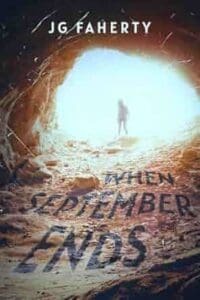
Right now, I’m currently pitching a supernatural eco-thriller that really stretched my writing, I think, as it’s a type of story I haven’t done before, and I’m currently half-way through writing another novel that is very much traditional supernatural horror, but without any of the gore found in the Nightmare World trilogy. In June I’ll be at StokerCon in Connecticut, and in October I’ll be at the Myrtle Beach ComicCon. I’m still working on other events in between.
Other than that, you can find me on the golf course, at the beach, at a local food truck rodeo, or just sitting in the backyard sipping a bourbon.
Andrew, I just want to say thank you for having me as a guest; your questions are always thought provoking and interesting!
About the Author
Born and raised in New York’s haunted Hudson Valley and more recently a resident of North Carolina’s equally haunted Cape Fear region, JG Faherty is the author of 23 books, 4 collections, and more than 90 short stories, and he’s been a finalist for both the Bram Stoker Award (twice) and ITW Thriller Award. He writes adult and YA horror, science fiction, dark fantasy, and paranormal romance, and his works range from quiet, dark suspense to over-the-top comic gruesomeness. He is proud to be a relative of Mary Shelley. You can follow him on X, Facebook, and Instagram as @jgfaherty.
The post Interview with Author JG Faherty: The Malthusian Correction and The Nightmare People appeared first on L. Andrew Cooper's Horrific Scribblings.
Interview with Author J.G. Faherty: The Malthusian Correction and The Nightmare People
Almost two years since our last interview, accomplished author JG Faherty checks in to discuss two horror novellas, The Malthusian Correction and The Nightmare People, both on the edge of release, very different stories but both stunning–enjoy the insights!
The Malthusian Correction (available May 27, 2025!)When Roger Brenner leaves the house because he has the urge to take a walk, no one, not even him, realizes he is about to change the world as we know it.
Roger’s sudden desire quickly turns into something more as both his mind and body begin to change. He is consumed by his need to keep walking, and soon he is leaving the small town of Rocky Point behind. By the time his family realizes he’s gone, he’s miles away and entering an altered state of consciousness.
As the days go by and Roger continues his unnatural journey, his body begins to deteriorate. He also attracts followers, all of them murmuring the same chilling phrases: “Walking” and “Must keep walking.” The growing horde travels down the East Coast, getting larger every day, with more and more of the walkers devolving into shambling, undead creatures. In less than a week, the phenomenon spreads across the world, causing religious and political upheaval. The governments fear it’s a disease. Religious leaders claim it’s a sign of the apocalypse. And scientists say it’s nature correcting overpopulation.
The same questions plague all of them:
When will it end?
And what happens next?
The world is about to find out.
 Click the pic for more on Amazon!
The Nightmare People
(available June 10, 2025!)
Click the pic for more on Amazon!
The Nightmare People
(available June 10, 2025!)Forty years ago, rookie cop Bill Furman pursued suspected serial killer Arthur Blanke into the basement of Blanke’s house and witnessed something that has given him nightmares his entire life.
Blanke turning into a demon and disappearing from a locked room.
Now Furman is Chief of Police, and gruesome murders are once again rocking the small town of Moonrise Cove in North Carolina. Children and their parents torn to pieces. Other children missing. The crimes are eerily similar to the ones Arthur Blanke committed. But they also seem to have something to do with Allison Navarro’s family. Furman is aware Allison and her children survived an attack by a similar serial killer in Rocky Point, New York, twenty-five years ago. His suspicions about her family’s involvement grow stronger when Allison’s estranged son, Ken, is arrested at one of the murder scenes telling tales of a Japanese demon, the oni, being responsible.
Furman’s life is turned upside down when he and Ken come face to face with the demon and he learns that it’s been responsible not just for the deaths in Moonrise Cove and Rocky Point, but for hundreds, perhaps thousands, of deaths around the world. Because the oni is the Boogeyman of legend.
And it’s out to finish the game it started decades ago.
 The Interview
The InterviewThe Malthusian Correction
1. The Malthusian. The description of The Malthusian Correction (above) overstates the unity of scientific opinion in your book, but one character does refer to population correction and the theories of the eighteenth-century political economist Reverend Thomas Malthus, named in your title. I’m only familiar with Malthus because of a very weird course I took in college. How did you come across his thinking? What gave you the idea of exploring his ideas in horror fiction? Did Malthusian thinking spark the idea for the novella, or did its inclusion come later? Either way, how did this unusual storyline take shape in your mind? To some, Malthus’s ideas might seem a little crazy… but he was a legitimate forerunner of Darwin, whom history takes much more seriously. Do you think there might be any validity to the idea that nature could “correct” overpopulation through its own devices? Why or why not?
JG: I was a biology major the latter half of my college years and also in grad school. One of the classes I took involved population modeling for an ecosystem, and we briefly touched on Malthus’s theories as they related to biological systems—like what you see in rodent populations when things get too crowded, or when predator-prey numbers get out of whack. Of course, that was 40 years ago, so I had to go back and look up some of the details to make sure I remembered things correctly.
The idea for the story didn’t come from that, though—that came from me reading the news and seeing all sorts of stories about plane crashes, wars, rising murder rates, etc., and wondering “what if all of this, the death tolls, the rising hatred and frustration we see in social media, the so-called ‘accidents,’ was really just the result of us over-populating the world? In nature, when one species gets out of control, some kind of check always balances it out. Either predator numbers increase, or the species consumes all its food sources, and starvation thins the herd. In rodents, especially mice and rats, if there are too many in a closed system (like a cage), they begin to murder and even cannibalize each other. Heck, even primate troops resort to violence when things get crowded, either killing or driving out members of the tribe.
So, once I had my plot, it was simply a matter of figuring out the basics: what tone did I want (scary, weird, action-oriented), what kind of correction would it be, and what was the outcome. And the answer came to me almost immediately. Lemmings. Now, we know that in real life, the whole idea of lemmings committing mass suicide is not really a thing. But it was perfect for my story, and since lemming suicide isn’t real, I needed a different scientific explanation. And that’s where natural correction came in, and from that the side-track of Malthus, and from that both the tone (weird) and the title.
It sounds like a lot, but I needed probably all of ten minutes to think of the plot once the idea appeared and another ten to look up the Malthus information to make sure I remembered it correctly.
As for my premise being true (nature correcting overpopulation), who knows? I do believe that overcrowding leads to violence and anger and stress. I think it’s why you see more violent crime in cities than in suburbs or the country. The more people you have jammed together, the higher the stress levels and the shorter the tempers. And in a way, rising grocery prices are the modern equivalent of natural resource shortages. Look what happens when there are empty shelves in the stores. People instantly turn feral. Most of us are one bad month, socio-economically, from going full lizard-brain.
The real question becomes, is there an overall driving force behind all this—God, Mother Nature, some higher power or almighty entity—or is it just how all things are hardwired at the most basic genetic levels? That any species will inherently do the same things in a similar situation because that’s simply how it has to be for nature to work properly?
I actually have a couple of short stories that explore this from different angles, which I hope will see the light of day (publication) in the near future.
——————
2. The Surreal. When Roger’s wife tries to communicate with him during an early phase of his walk, she experiences the interaction as “like a dream. Or an acid trip.” Readers know Roger feels “purpose” in walking, but the nature of that purpose—the motivation behind his and others’ bizarre, self-destructive behavior—remains obscure, making me feel like Roger’s wife does during that early moment through much of the story. Did you set out to create a surreal reading experience? If so, why, and what aspects other than the walkers’ bizarre behaviors contribute to the surreality? Either way, what do you think “acid trip” moments contribute to the story’s horrific impact? What does the bizarreness of what’s happening do to people in the world of the story, and what do you expect it to do to people reading the story?
JG: I absolutely wanted the entire story to feel surreal, but not in a Twilight Zone way. I was going for weird. Keep the reader guessing to the very end, yet with a few clues scattered around. I didn’t want “scary.” Not in the usual sense. In order to do that, and to make sure neither Roger’s wife nor the authorities could stop him and his followers, I had to create something that was somewhere between zombie and fanatic. One of the examples I use in the story is when Roger’s lawyer reminds people that no one blinks an eye when someone wants to walk across the US for charity or swim the English Channel or do other crazy-sounding stuff. But I also needed Roger not to be “normal” anymore. Is it a disease? Has he been taken over by a higher power? Obviously, something supernatural is at play, as we see throughout the story’s progression. But it’s slow, and by the time people realize it, the whole phenomenon is in full force.
In a way, this is an offshoot of a non-zombie, non-apocalyptic zombie apocalypse novella I wrote (along with a follow-up short story) a few years ago. It’s called December Soul (the short story is “The Lazarus Effect”). Both are in my collection Houses of the Unholy, and they describe how a growing segment of the population suddenly stops eating, stops speaking, and just starts gathering in large groups. Wherever those groups appear, more people become like them and join them. No one knows why. No one can explain how they don’t starve to death or die. But as more and more of them happen, suddenly society is in trouble because it’s breaking down. All these peaceful people just standing around or walking in big groups through the streets and parks and neighborhoods. I won’t give away the ending, but it turns out to be something other than what it seems to be.

That was another part of The Malthusian Correction that I enjoyed exploring. The idea of zombies that didn’t eat brains, weren’t violent, weren’t really zombies except that they were dead and still walking.
My hope for this story is two-fold. One, that readers are entertained. And two, after they experience the thrills and chills of the story, the chills part sticks with them and comes back each time they read the news about another plane crash or mass murder.
——————
3. Voyeuristic Frenzy. You provide a fair bit of information about the media response to the walker phenomenon, and some media representatives seem to try to prolong the phenomenon because it gets good ratings. Are you critiquing how media outlets tend to respond to unusual and potentially tragic events? Showing what you think would be a realistic response to such events? Both? What about people who come to watch the walkers as their numbers grow—does your book judge their voyeuristic curiosity? Why or why not? What’s significant about the desires to see and to know that you portray? How do they relate to your readers’ desire to “see” and know more as they read along?
JG: I think it’s a pretty realistic representation of how we’ve seen both media and onlookers react to tragic and tumultuous events. Would the media exploit something like this? Absolutely! Look at coverage for everything from storms (often blown out of proportion for days in advance), wars, politics, everything. It’s 100% about ratings now, and scooping the competition, and keeping people glued to their TVs, phones, etc. There is no journalistic integrity anymore, and even if a reporter had some, the station would either poison it or fire them.
As for the people—there would definitely be hordes of onlookers. People come from miles away to see anything unusual. Dead whale on the beach? Let’s go! Brush fires in the hills? Let’s drive past and see them. Sinkhole opens up? Plane crashes in the woods? Gotta check it out! It’s simple curiosity, and in some folks it overrides common sense. You’ve seen them. The ones that have to get right to the very edge of the Grand Canyon, where one wrong step sends them over the edge, just for the perfect selfie. The ones who stand and watch while a crime is being committed, like a bank robbery or a hostage situation, all of them right up to the edge of the police barriers. Do I think people would come watch dead people marching through town, even at the risk of becoming one? Yes, I do.
Does that relate to readers wanting to keep going with the book? No, I don’t think so. One is voyeuristic curiosity; the other is being caught up in an interesting story. Although I guess an argument could be made that the onlookers are there because in a way they’re being entertained.
——————
4. Religious Frenzy. When Roger’s wife tries to stop his walking legally on mental health grounds—he may be a danger to himself or others—people object for various reasons, particularly because he has a right to go on a religious pilgrimage even if doing so is detrimental to his health. Why are people so quick to ascribe religious significance to his seemingly inexplicable behavior? As more people join the walk, religion and public health concerns come more and more into open conflict. To what extent did similar conflicts over vaccination, particularly during the COVID crisis, influence your representation of this conflict? Does your book take a position? Why or why not? Caring for the mental health of walkers seems to be especially at odds with religious aims. How does this conflict resonate with what you see in the world outside your fiction?
JG: One of the things I’ve found about my writing is that rarely are the underlying themes or subthemes—in this case, religion vs. science, religion vs. politics, politics vs. science, etc.—part of what I have in mind when I start writing. Often, I don’t even catch them until after I’m going back to edit, or, in some cases, when reviewers mention them. That was a huge shock for me when I wrote my very first novella (The Cold Spot) back in 2012 (wow, so long ago!). In that book, I came up with the title because the main character, a kid who’d been bullied because of a birthmark on his face, discovers a cold spot in a cemetery that is from the presence of ghosts. It was only later, when a reviewer pointed things out, that I realized the title had multiple meanings. The boy’s birthmark (he’s cruelly nicknamed Spot) has turned him emotionally cold. And he’s placed in situations where the people (and ghosts) closest to him end up doing terrible things (he is in cold, hard environments).

A similar thing happened with The Malthusian Correction. I definitely wanted there to be some involvement with religious groups. How could there not be? Once it’s shown that Roger and his followers are dead but not-dead, and especially after the one scene where they should all be dead but they “return,” it’s like events from different religious tales are occurring in real life. Is it a second coming? Is Roger Jesus? Is it the apocalypse? Or, as some of the atheists and scientists proclaim, does it mean that there is no heaven, no hell, that non-death, or after-death, is simply another state of being? Do the dead have souls, or are they simply automatons?
Religious groups would be arguing like crazy. And, again reverting back to basic human nature, new religions would spring up. Humans are nothing if not predictable.
On the other hand, when it came to the health aspects of the situation (dead people marching through towns, possibly carrying deadly diseases), I had no thoughts about COVID as a key plot point. I simply went with what I thought would be a standard healthcare and military reaction to a situation like that. I’ve worked in the biological sciences, including some time working with infectious diseases, and I have friends who are virologists and bio-geneticists. Who’ve worked at the CDC or NIH. I didn’t want this book to be a statement about COVID; however, there were obviously some basic parallels because even if COVID never happened, a situation like this would still require an epidemic/pandemic-type of response at some point. Those procedures were always in place; COVID simply made more people aware of them.
——————
5. The Walking Dead. The description of your book mentions the walkers becoming “undead.” I’ll venture that it’s atypical, but how is and isn’t The Malthusian Correction a zombie story? You give Jonathan Maberry and Brian Keene cameo appearances and mention other horror along the way—what works were your major influences? Did you set out to write a fresh take on the zombie? If so, why do we need a new zombie for 2025? If not, even though the Z word is one of many conceptual frameworks people use to try to explain your walkers, how are your walkers not zombies? Why would and/or wouldn’t you want to put The Malthusian Correction in the zombie subgenre?
JG: I’ve written a lot of zombie stories, despite the fact that I don’t typically enjoy zombie stories (or movies, or TV shows). The reason I don’t usually enjoy them is they are so predictable. Slow moving zombies take over the town, or the world, or whatever. Fast moving zombies take over the town or the world, or whatever. People have to band together to stop them. Keene’s zombies were a bit different because some of them could think. Maberry’s zombie books are good in large part because he focuses more on the people than the zombies, making the terrors more realistic. But stuff like The Walking Dead, man, that gets old real fast. That series should’ve stopped after Season 3. Same with The Last of Us – it’s already reaching the point where it’s right back to the overused “warring communities” plot. (I can’t comment on either of the comic series because I don’t read comics much and haven’t since the mid-90s.)
What happens with me is that when I come up with a zombie-type story, I immediately throw it out unless it happens to take the genre in a very different direction. For instance, in “Home on the Range,” zombies are trainable and can be used as day labor and illegally as sex workers. In “Family First,” a man succumbs to a zombie bite and then wakes up to find that as long as he eats brains, he can remain a normal, fully functioning rational person, and now he has to rescue his family before the zombies get them—except the effects of brain eating only last a few hours. In “Marshal Law,” the reanimated corpses have an agenda, which you can guess from the title. In “Street Action,” zombies are part of society but there is a serious prejudice against them, and one decides to rebel. Most recently, “Mezzamort” is featured in the GabaGhoul anthology, with warring zombie mobsters as the heart of the plot.

I love taking the idea of the zombie and turning it around, twisting it into new shapes, making it something it’s not. So, as I wrote The Malthusian Correction, I consciously made sure it wouldn’t be a Walking Dead knock-off. Are Roger and his followers zombies? I guess that depends on your definition. At some point, they are dead. And they still move. If the definition of a zombie is that, then yes. But then vampires, mummies, ghouls, Frankenstein’s monster, and lots of other scary creatures would be zombies. Roger et. al. don’t eat flesh. Don’t kill anyone. Haven’t emerged from graves.
Would I put it in the zombie subgenre? Maybe, in the broadest sense.
Do we need a new zombie for 2025? Probably, and probably not. Unlike me, a lot—a real lot!—of people enjoy the tried-and-true zombies. So I think you could maybe have a new kind of zombie, but it would be in addition to the classic ones, rather than replacing them.
——————
The Nightmare People
6. Nightmare Influences. References to serial killers run through The Nightmare People. On the one hand, serial killers are a rationalization of the demonic, but on the other—are serial killers the kernel of your monster’s horror? A real serial killer, John Wayne Gacy., who killed children, gets mentioned at least once, and a fictional serial killer who kills children, Freddy Krueger, gets mentioned at least twice. In his movies, Freddy gets called “the boogeyman” and is certainly a nightmare person—how do real-life child-killing nightmare people, movie-spawned child-killing nightmare people, and your child-killing boogeyman relate? Your novella also mentions Stranger Things, a TV show in which entities from another realm repeatedly threaten kids. Your story alludes to another realm, and “Nightmare People” might refer to characters having nightmares as well as “people” monstrous enough to inspire nightmares—would you place your novella in a cluster with serial killer stories, Nightmare on Elm Street, and Stranger Things (perhaps with the horror turned up to eleven)? Why or why not?
JG: Wow, that’s a lot to unpack! Like I mentioned above, I don’t usually think about that deep stuff when I’m writing, at least not consciously. I think, for my thought process, it was more basic. If the boogeyman really did exist, it (or they) would be considered the most outrageous and prolific serial killer(s) / psychopath(s) in history. Frightening children. Stealing them. Killing them. Depending on which legend you examine, the boogeyman (or equivalent) is pretty awful.
With that in mind, I had to look at it from a cop’s point of view (because in book 1 of the trilogy, The Nightmare Man, a cop was one of the main characters, and that continues into books 2 and 3). No cop is going to believe in a supernatural serial killer. Heck, my two cops don’t, and they’ve both encountered the boogeyman! In these books, the cops do what most people would: try to rationalize what’s happening. The pop culture references, like Freddy Kreuger or John Wayne Gacy, I threw in because I think people would talk about them in conversation. The cops I know certainly would. And the manner of the deaths—the bodies being sliced up, chopped up—is reminiscent enough of horror movies to make those comparisons logical.

Imagine you’re in a dimly lit room and you see this tall, monstrous thing with long claws butcher someone. All adults know monsters don’t exist. So there’d very quickly be rationalizations. Man in a gorilla suit. Man with home-made Freddy Kreuger knife-gloves. Eventually, our heroes come to accept that there is no rational explanation except that the kids in the story are right: it’s the boogeyman. But without having seen it themselves, many of the adults, including FBI agents, learn the lesson too late.
I suppose that someone somewhere has done psychological studies about serial killers of children, people who think they’re the boogeyman, who were scarred as little kids by those stories or by being victims of serial killers or whatever. My books aren’t the place for that. I think if you start going that deep with what is essentially a horror thriller, you steal some of the inherent fear from it and it becomes more of a study object than entertainment.
I just wanted my cops to act like cops, my kids to act like kids. To be scared. To be wrong.
As for where I’d place this in the genre, I think I’d shy away from calling it a serial killer book. Sure, the boogeyman is a serial killer in the strictest definition, but then so would be Dracula. The Mummy. Any monster with a list of targets to kill. That would make my mummy novel Ragman a serial killer book, too! It’s a police procedural just like the Nightmare World trilogy. Maybe that’s the best description: Supernatural Police Procedural.
 Mummy with a mission!
Mummy with a mission!——————
7. Nightmare Images, International Boogeymen. This novella is gory, and a lot of the flying body parts belong to kids. Do you feel that it’s risky? Why did you decide to be so explicit? Even though the U.S. has come a long way in terms of what it will allow onscreen, I imagine a film adaptation would tone it down a bit… but as the description (above) indicates, your monster is global, so a film adaptation wouldn’t have to come from the U.S. The “oni” is Japanese: does your rather extreme monster have any relation to Japan’s historically more extreme horror cinema (the works of Hisayasa Sato and Takashi Miike, for example)? Even if it doesn’t, for your mostly American characters, does the oni’s foreign dimension increase the terror it inspires (the only thing Japanese most of them seem to know is Godzilla, mentioned twice)? Ultimately, how does your monster’s global reach affect its grisliness?
JG: Well, I don’t imagine there’ll ever be a movie made from this trilogy! Like you said, chopping up dozens of kids isn’t what most moviegoers are looking for. What made me be so explicit was I never had any intention of pitching this trilogy to a Big 5 publishing house. I knew as soon as I started writing that it would be a little gorier than what I normally do (but let’s be honest—it’s not “extreme horror” gory; it’s not Human Centipede gross or even Texas Chainsaw Massacre bloody; however, it’s kids, so….) and that it would either be something for the small press or to self-publish. Luckily, Lycan Valley Press liked it and agreed to do all three books.
It’s funny that you mention Japanese horror. It was the oni legend, through the game of hitori kakurenbo, that crystallized the plot for me. I had this real vague idea about a boogeyman who follows a boy from childhood to adulthood, but I didn’t want to do the US version of the boogeyman because it’s so familiar. So I started googling boogeyman legends, and I came across the Japanese one and also the Puerto Rican one (the cuco). That’s when I had the idea that two different people could be haunted by the same monster, and if they somehow came together… So, in order to do that, I had to have Ken play the hitori kakurenbo game as a little boy, call forth the oni, and set everything in motion.
And here’s a little secret: Aside from the Godzilla universe movies and a couple of other films (Ringu, Dark Water) I’ve not seen much Japanese horror, and I can’t stand anime or manga; in fact, the inclusion of that type of drawing is what made me stop reading Marvel comics in the 90s. So that style of horror had zero influence on these books. I simply chose a Japanese setting to start the trilogy because it made the best sense as a plot initiator.
——————
8. Monster! When they see your monster, several characters shout, “Monster!” Encountering it seems to make knowing it is a monster almost instantaneous and inevitable. This thing isn’t Frankenstein’s sympathetic Creature. There’s no doubting this thing is bad news. What allows characters to recognize the creature’s undeniable badness? You emphasize sensory details. Why the glowing red eye? What aspects of size and shape make the monstrous? Why the animal features—hair, teeth, claws? What about sounds? Why so much emphasis on smell, and why the specific smells? To sum up with a big word, what’s the key to your epistemology of monstrosity?
JG: The thing about horror is, when you start writing about monsters, how can you create something new yet familiar? How do you describe something that everyone knows, and yet still make it scary? Conversely, how do you describe something no one’s ever seen before and make it scary without going overboard on details?
This was my conundrum for the boogeyman creatures in The Nightmare Man, The Nightmare People, and, preparing for line edits as we speak, the final book in the trilogy, The Nightmare World. In the US, the boogeyman is described in all sorts of different ways. But one of the nice things about the Japanese oni and the Hispanic cuco is that they actually look similar. Big, ogre-like or Bigfoot-like creatures, hairy and toothy and really mean. To that I added my own details: red eyes (yes, it’s been done a lot, but I wanted them very visible in the dark) and an awful smell. I mean, think about it. All those fables and bedtime stories about boogeymen, but none of them go beyond how they look and maybe that they whisper or growl.
They’re monsters. Monsters that live on human flesh and carve people into pieces. Meaning they have to get covered in gore. And you know they aren’t showering when they get home. They should stink really bad. I tweaked that a little to add the fart smell. Why not make them stink as bad as they look? Plus, smell is a great way to foreshadow the appearance of one, or realize one has been there in the aftermath of a murder.
There’s also this: any good writer or editor will tell you that a story should encompass as many senses as possible, not just vision. It helps immerse the reader in the story.
The reason for the claws: gotta slice them bodies up somehow.
The reason for the teeth: gotta eat that flesh, plus they’re scary looking.
Nice thing about a monster is that I can create a whole race of boogeyman creatures, and they can be different from everyone else’s, but it’s still right, because there is no wrong.
The one thing I try to do, though, with all my monsters, is make them believable. Sometimes a monster can be so “out there” that it becomes laughable. I don’t want that. I create my monsters—whether they be boogeymen, Lovecraftian beings, mummies, ghosts, were-creatures, zombies, Krampus, etc.—with a healthy mix of legend and scientific possibility. Not probability, but they pretty much adhere to the natural laws of physics and somewhat with the laws of nature and biology. Although I have no problem stretching those!
The last thing I want is someone reading one of my books and thinking, “that monster is stupid.”
I want them to say, “oh, hell, this almost seems like it could happen.”
——————
9. Big World-Building, Short Book. You do so gracefully, but you squeeze a lot of world-building into this short book, developing not only a significant cast of regular people but also a monster associated with deep lore and a realm you merely sketch. What’s the personality of Moonrise Cove? Without giving too much away, what sorts of things can readers expect to learn about the demonic oni and its realm? With all the world-building you’ve done, do you expect to revisit some of this material—might there be more from the realms of The Nightmare People?
JG: From the minute I came up with the idea for The Nightmare Man, I knew it would be a trilogy of novellas. The way it was structured in my head and in my first outline wouldn’t work with a single novel, even if that novel went 120,000 words. Too many ups and downs in terms of climaxes.
And I saw everything clear as day. Book 1 (The Nightmare Man) would set everything in motion. Two of the three key characters (Ken, Rob) and their family, and the history of the oni/cuco in their lives. Book 2 (The Nightmare People) springs us both forward and backward in time, as we meet Chief Furman and find out his involvement with the boogeyman and set up the intersection with him and Ken’s family. Book 3 (The Nightmare World) will take us back to that place where Rob and his daughter visited, the alternate reality where the boogeymen come from.
At the same time, the titles show how the cast and stakes grow larger: Nightmare Man represents both the oni/cuco and Ken or Rob. Nightmare People gives us several more characters dealing with the demons. And Nightmare World will not only take us across the divide, but it also represents how bad the situation in Moonrise Cove has become.
Nightmare Man takes place in the fictional town of Rocky Point in upstate NY. When I wrote it, that’s where I lived (it’s based on a combination of two towns, Stony Point and Haverstraw) and where a lot of my books and stories have been set. When I moved to North Carolina in 2024, I created the fictional town of Moonrise Cove, which is situated between and above Wilmington and Leland. The next question is going to be why do that, and my answer is, I like writing about the areas where I live. Especially small towns. You can work in so many tiny details that make a story more authentic.
And I won’t lie, it comes in handy when the local library or bookstore is looking for a “local author” for an event or if you want to sell your books locally and you can say “takes place right here in town!”
Of course, I’ve also written about places I’ve visited a lot (Ragman is set in NYC, Hellrider is set in the Everglades of Florida) or previously lived (upstate NY, the town of Olean, where I was born and went to college, is the basis for my town of Hastings Mills and the setting for books such as The Wakening and The Burning Time), and also places I’ve never been. But sooner or later, I end up writing about “home” again.



——————
10. Access! How can readers learn more about you and your works (please provide any links you want to share)?
JG: Well, the easiest way to keep up with me and what’s going on is to visit either my website (www.jgfaherty.com) or my Facebook page (www.facebook.com/jgfaherty). I’m also semi-active on X (@jgfaherty) and Instagram (@jgfaherty). My books can be found on Amazon (JG Faherty) and Barnes & Noble.com (also JG Faherty). In addition to The Malthusian Correction and The Nightmare People, I also had another novella come out in April (When September Ends, a story about a girl haunted by the evil ghost of her dead sister). Later this year I’ll have some short stories coming out in various magazines and anthologies, and probably late this year or early next will see the release of The Nightmare World, concluding that trilogy.

Right now, I’m currently pitching a supernatural eco-thriller that really stretched my writing, I think, as it’s a type of story I haven’t done before, and I’m currently half-way through writing another novel that is very much traditional supernatural horror, but without any of the gore found in the Nightmare World trilogy. In June I’ll be at StokerCon in Connecticut, and in October I’ll be at the Myrtle Beach ComicCon. I’m still working on other events in between.
Other than that, you can find me on the golf course, at the beach, at a local food truck rodeo, or just sitting in the backyard sipping a bourbon.
Andrew, I just want to say thank you for having me as a guest; your questions are always thought provoking and interesting!
About the Author
Born and raised in New York’s haunted Hudson Valley and more recently a resident of North Carolina’s equally haunted Cape Fear region, JG Faherty is the author of 23 books, 4 collections, and more than 90 short stories, and he’s been a finalist for both the Bram Stoker Award (twice) and ITW Thriller Award. He writes adult and YA horror, science fiction, dark fantasy, and paranormal romance, and his works range from quiet, dark suspense to over-the-top comic gruesomeness. He is proud to be a relative of Mary Shelley. You can follow him on X, Facebook, and Instagram as @jgfaherty.
The post Interview with Author J.G. Faherty: The Malthusian Correction and The Nightmare People first appeared on L. Andrew Cooper's Horrific Scribblings.
May 14, 2025
Interview with Author John Boden: Thrift Store Puzzles
A day after its launch, elegant horror author John Boden is here to discuss his novella Thrift Store Puzzles, touching on the terrors of time, aging, and many kinds of loss–oh, and vampires.
Thrift Store PuzzlesKen Allenwood is a man being devoured from the inside out, one memory at a time. A once-famed horror writer who now spends his days in an elder care facility waiting for the breath that will be his last and hoping he’ll retain at least some memories from his long and unusual life, Ken is over 130 years old… or is he? Has the unraveling fabric of his mind tangled with the threads of his fictive endeavors?
Elijah is a boy who adores all things spooky, a boy who spends the bulk of his time alone, his single mother juggling jobs to keep a roof overhead and food in their bellies. Eli occupies his days hanging out at the home across the street with his uncle/pal, Tierny, one of Mr. Allenwood’s many caregivers, as well as with Allenwood himself, their afternoons filled with cheesy scary movies and the old man’s recollective stories (while he is still able to tell them).
Then a change comes to the little town of Cordry. The killings are vicious and devoid of pattern, almost. When Elijah tells Ken about them, the old man grows fearful and decides to use his unreliable windows of focus to help his friends figure out what is going on and who or what is behind the murders.
A monster has come to roost in their midst. A creature that craves blood and possibly much more, inheritance of a sort, acknowledgment. A monster from the very dark recesses of Allenwood’s mind, a horror very old and very bitter. The things we create have a tenacity, a stubborn strength and a very vicious bite.
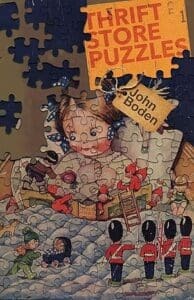 Click the pic for more on Amazon!The Interview
Click the pic for more on Amazon!The Interview1. The Mysteries and Horrors of Time. Early in Thrift Store Puzzles, a character reflects that time is “all we really have,” a thought I find particularly terrifying in the context of a story with a lead character losing time—losing memories, losing track of his place on a timeline—due to senile dementia. What is your book’s philosophy of time? Would you say time is one of the monsters, perhaps even the primary monster, in your story? Why or why not? For Elijah, Ken’s extreme age—whatever the actual number may be—seems fascinating. What is the fascination? Is it morbid? Why or why not?
JB: Time is always a monster, isn’t it? It’s that faceless thing we’re given a born-in awe/fear of that has no physical face to turn away from, a thing that we see, always, the crimes committed by—the grisly afterstains, but we are absolutely powerless against it. I’m not exactly sure I’d say it is the primary monster in TSP… that is the dementia, which is a monster that the monster of time must surely fear. It eats the crumbs that time allows us, the memories and lessons learned. That’s all it does really. It erases and eats, and I find that tragically terrifying, and while I wish it weren’t so, I’ve seen it up close and watched the husks it leaves. Losing loved ones twice… I purposefully placed the characters here on different bases on the time playingfield. Ken, regardless of actual age, is rounding third whereas Elijah is running to first, and the whole game in his future. It is a fascination but not a healthy one, kinda more like when you encounter someone or something that gives you that feeling, and you warily keep an eye on them from then on, just in case.
2. Writer Stories I: Horror’s Writer/Writing Fetish. Thanks largely to Stephen King (but the tradition goes back much farther), the “writer story,” a tale with a writer at its center, is a popular subgenre in horror, and since Ken both is a writer and his writing is important to the story, Thrift Store Puzzles fits right in. Why is this subgenre so popular, particularly in horror? What drew you, as a horror writer, to craft a tale about a horror writer? In what ways might your writing about writing make your book self-reflective? How might this self-reflective dimension increase the book’s dark-and-scary factor?
JB: As with a lot of my works, it was accidental. I’m not very normal in the way I do things. With my books Spungunion and Snarl, I came up with the final scenes first and then wrote the story to get there. With this one, I set out to write a Boden-version of a vampire novel. That opening was to be the opening of that. During the period of time I was working on it, I was watching dementia use its claws on my father-in-law, who was a great and lovely man. And the more that went on, the more this new trajectory started to reveal itself. The character of Tierny was named for a friend who was going through the very same horrible situation with his partner, and my heart broke for him… as it breaks for everyone all the time. Self-reflective is just how I write, always. If I don’t feel about it–how do I expect others to feel it? If I peel back my skin, you’re more likely to be okay with your own flaying. We all cut ourselves to ribbons a hundred times a day and bleed quietly under our uniforms and suits. I once had a conversation with the late Dallas Mayr (Jack Ketchum) and he told me to write what I knew, and I couldn’t go wrong. It was, to date, the best advice I’ve gotten, and I clutch it as treasure. I put so much of myself, my history and life, into my stories, oft presented as fiction, but the authenticity it adds can’t be faked. I don’t think.
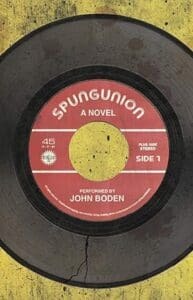
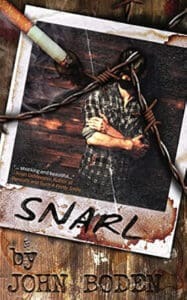
3. Loneliness. My emotions got unusually involved with your characters, each of whom—Ken, Elijah, Tierny, even the monster—struggles with a profound loneliness. Why the widespread loneliness in this fictional world? With Elijah, Tierny, and Ken, we see man in different stages of life. How, in your novella, does the loneliness of youth compare the loneliness of adulthood and the loneliness of old age? To what extent are sadness and isolation constants that go along with the predation of time?
JB: Everyone is alone, even when they’re with people. Even when they’re loved. Elijah pines for the inclusion he feels he’s missing out on with friends his age, not quite realizing a lot of his exile is self-imposed. Tierny is much the same but for wholly different reasons. A closeted man in a very small town must navigate carefully, at least that was how I saw it in the 80s when I was an early teenager and began to suss out how things work. Even then, I recall thinking about how horrifying it must be to have to sneak and hide yourself almost always. Sadly, not much has changed in a lot of the world. I felt it was important to paint Tierny as a composite of some older friends I had as a teenager. Not one single time was sexuality ever discussed. I knew they were different but didn’t care. Friends are friends are family. And that’s why I chose to handle Tierny’s “loneliness” as I did. Loneliness is just time again in a fancier suit.
4. Poetic Prose. Whoever your bio (below) refers to who said your writing style stands out deserves repeating: your style has unusual, often poetic qualities, especially as you delve into your characters’ inner struggles. How would you describe the style you use to create the atmosphere and mood(s) of Thrift Store Puzzles? What techniques or approaches do you use to make the words on the page feel right? Does your style change much from work to work, or should readers expect the writing in Thrift Store Puzzles to be very similar to that in your other tales? Thrift Store Puzzles is very new at the time we’re doing this interview: what about it suggests steps forward in your development as a writer?
JB: Heh, I have been asked about my style so many times, and I always feel like a dick with my answer. It’s just how it happens. I have a head full of words–I’ve been stuffing that reservoir since grade school, and I love nothing more than playing with them and putting them together in weird ways, offbeat combos that make them mean entirely unique things they really ought not. I don’t put much thought into it. I just (when I’m writing) start typing and see what happens. The earliest stuff I wrote was poetry. I have never forgotten how it feels to compose that way, and so it’s how I approach my fiction as well. The first thing I ever had published (of my solo work) was a chapbook called Dominoes, which was made to resemble a children’s book but was filled with poetic shards of prose fiction pieces all concerning the end of the world in a myriad of ways. I also used poetry as interlude chapters for the novella Snarl, in which the main character is a guy who likes to write poetry but lacks the courage to send it into the world. So all of that is to say, I don’t really know why I write the way I do, but I consider myself fortunate that folks seem to like it and that it is has become somewhat of a signature style. One fella told me once I write like Ozzy vocals. The first word of the first verse sung and you know. I’m a huge music nerd, so I dug that.
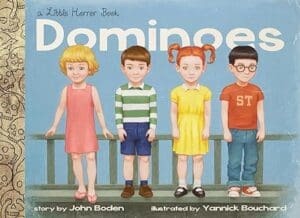
5. Writing Perspectives: Boy, Man, Monster. As we’ve already begun to discuss, you reveal the thoughts and feelings of characters at different stages of life as well as of a monster whose very existence is a mystery. While they have feelings like loneliness in common, each perspective is distinct. What about the perspectives primarily distinguishes Elijah from Tierney and from Ken (and various vice-versas)? What’s the significance of the commonality between the monster and the protagonists? Loneliness is a defining characteristic of one of history’s most famous monsters—Frankenstein’s Creature—who is sympathetic despite his murderous rampages. Do you want readers to sympathize with your monster? Why or why not?
JB: I’m not sure I want sympathy for the monster. I mean, most monsters are owed a sliver of sympathy, and The Mouth is sure no different. I could go into why, but it would be spoilery, so I won’t aside from saying the commonality between the monster and the other characters is intentional. This particular monster is so metaphoric in a lot of ways that it being somewhat composite in many ways was unavoidable. Almost as though it were a depository where all that Ken lost, all that Tierny had to suffocate to survive, and all that Elijah had yet to experience, all of that languished and congealed and germinated into being. It could almost be said that, dementia/monster aspects aside, the three main fellas in TSP could just be one man in those three distinct phases of his life. Even allowing the inclusion of the dementia that would still hold, because that reduces one to almost mental infancy at the end, which is yet another of the things that make it so cruelly tragic.
6. Writer Stories II: Creative Forces. Questions about the creative power of horror fiction, which I’ve traced back to the beginning of the Gothic in the eighteenth century, tend to become major story elements in some writer stories, such as King’s The Dark Half and your new novella. In short, how might fictive horrors become “real?” The description of your book (above) offers Ken’s dementia as a possible answer: how literally does dementia change “reality” by removing Ken’s ability to differentiate between what he has experienced and what he has written? How do you feel about the possibility of losing the barrier in your brain that separates what you’ve imagined from what you’ve lived? Your book’s description suggests that the power of Ken’s writing goes even further: the monster killing people in reality may have sprung from his mind. What does this fiction about fiction possibly having this power say about the actual power of fiction? Do you think fiction actually creates monsters? Why or why not?
JB: Fiction definitely creates monsters, not in that panic-way that those who bemoan the dangers of horror movies and violent games bemoan, but in that fiction is a creature born of emotions. Thoughts drenched in love/fear/unease/remorse/grief and a million other feelings we can feel–crack your knuckles, crack open your brain, and hit the keyboard, and a monster will surely be loosed, with disregard of genre. You have brought the creature to life. The monster in TSP isn’t due to Ken’s dementia, that was more of a key left in the lock of a door. The door is opened easily, but can you claim someone broke in? Not really. Dementia left the key in Ken’s brain. He is no longer aware of that lock or maybe even the door… but our baddie found it. I am personally terrified of losing control of my thoughts and retention of memories. My memories are my treasure. So many relatives and friends have passed on, and all we have left are those memories, and they’re priceless. I’m not going to plod on with this answer much more as it gets me weepy, and I’m not up for that right now. I apologize.
7. Masculinity and Intergenerational Relationships. Elijah’s loneliness is at least in part what drives him to the retirement home where he befriends Tierny and Ken, men old enough to be his father and (possibly great- or great-great-) grandfather. Beyond mere company, what draws Eli to friendship with these older men rather than with kids his own age? That they’re possible father figures only begins to answer, I think—what specific benefits does their friendship offer the boy, and what, in turn, does the boy’s friendship offer them? What is he looking to learn about becoming a man, and what are they able to teach?
JB: He is related to Tierny so that friendship is kinda built-in, and I assume it was the catalyst that brought the boy initially hanging about the home. Then his love of all things horror was piqued when he found that a former horror writer was a patient there. His lack of friends his own age stems from several things, his awkward demeanor from being on his own so much, his smallness for his age, his preoccupation with subjects that most boys his age just aren’t into. In almost every way, Elijah was me at that age. He relishes the fact that these two adults treat him as an equal almost, Tierny out of relative respect being related, and Ken just because that’s how he is. But to Elijah that’s the world. I never really mention Elijah’s father’s absence because, as seems to be the case more often these days than when this was set, that’s just the way it is. More and more young people have question marks on the branches of their family trees, and I’m not really being judgmental, it’s how it is. So people build their own family, and friends are often afforded the same level of reverence as blood kin. And I’m completely okay about that. Someone once said that rarely do members of the same family grow under the same roof… something like that. The benefits of the friendships with the older men are simple, a feeling of acceptance and a warmth born of honest engagement.
8. Relating to the Vampire. Though the v-word describes your monster at times, you make clear the blood-craving entity is very unlike what people tend to expect from vampires. Without giving away too much, how would you describe your monster? Why did you tie him to the vampiric while being very careful to distinguish him from the vampire mainstream? Although these films are very different, your book’s connection of vampiric themes to themes about old age made me think of The Hunger (1983) and Cronos (1992). If you’re aware of these films, would you be willing to draw a line connecting them and your work? What do you think is your book’s major contribution to the vast world of vampire-related fiction?
JB: I initially set out to write a vampire book, more traditional, but, as is always my way, I fell from the path, and things got weirdly twisted. The Mouth is vampiric in that its driving force is hunger and it seeks to cement its existence through what it devours. Does it subsist solely on blood? Does it look dapper in a cape and in moonlight? No, The Mouth is an amalgamation of mountain magic/possession and plundering the trunk of an old man’s memories for clothing to wear. It’s an entity that on its own is bleak and scary, but once it shrouds itself in the vampiric memories of Ken’s fictions, it feels it’s found its identity. The connections to Ken’s dementia, while purposefully acknowledged, are not wall-bearing really. I’m kind of a “here’s a fistful of ideas I’m gonna throw in here” and we see what sticks and what just hangs there. I like to think The Mouth has as much of a place in the annals of Vampiric monsters as Christine (totally a vampire!) and the house in Burnt Offerings. Aging, as I rambled about time earlier on, is always a monster. Often THE monster. And it’s the one you’ll never outrun.
9. Coming of Age. Elijah seems to be your book’s heart. If this story is primarily his, is he coming of age, and is your story therefore a coming-of-age story? What does your answer mean for Eli and for your story? What’s the significance of growing up, or at least trying to, in a horror story? Why might the horror genre provide particularly handy tools for writing about the experiences of childhood?
JB: My interpretation of “Coming of Age” is most likely a bit different from most. I always look at it, if the character learns, then comes to settle into his place with some idea of where his trajectory now aims, then yes, it’s CoA. By that definition all of my books fit, as do many other works, and they don’t have to feature children in the role. Growing up is one of the scariest things in life, and we never really stop doing it. I feel like Stirring the Sheets by Chad Lutzke was a fabulous CoA that happened to be about an aging widower. The heart of the story is Ken, but without the circulatory system that is Elijah… bringing him the much-needed oxygen and blood (from the outside world) without which he’d assuredly shrivel and die. There are CoA books in all genres, but they do seem to wear the shoes well with horror. The only thing I can hang that on is that most of us fell in love with horror when we were children and have never really allowed that part of us to grow up. I know when I watch a favorite old scary movie or see a neat old monster toy when I’m out antiquing. The little me with the skinned knee and ripped jeans, the dirty sneakers (probably still untied), and the shirt with the peeling Frankenstein iron-on on gets excited and pushes to the front of my brain. That’s happens to everyone, right?
10. Access! How can readers learn more about you and your works (please provide any links you want to share)?
JB: I don’t have an actual website. I’ve attempted them in the past and as recently as last year I tried the Substack thing and then left it to starve like the others. I can be found on most social platforms. Just search my name, and you’ll find me. The best place to see what books I’ve got out there through a variety of publishers would be my Amazon author’s page, and I know lots of folks loathe dealing with the Zon but you could look and see what I have out and about. I check Facebook and Bluesky daily.
About the Author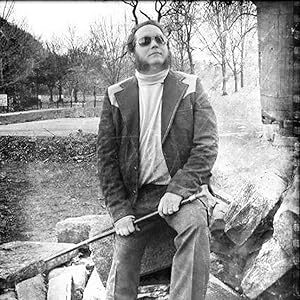
John Boden was mostly raised in the mountains of Pennsylvania, in the small town of Orbisonia.
He is a bakery manager by trade and finds a regular sleep schedule overrated.
He currently resides with his beautiful wife and two sons in a house sweetly haunted by the ghost of a beautician named Darlene. He likes collecting lots of things and won’t usually shut up about it.
His writing is fairly well received and has been called unique in style.
His work has been published in the form of stories in several anthologies and as novellas. He is slowly working on his first novel.
The post Interview with Author John Boden: Thrift Store Puzzles appeared first on L. Andrew Cooper's Horrific Scribblings.
May 7, 2025
Interview with Author Stewart Bint: When God’s Wind Blows
Author of multiple and blended genres Stewart Bint discusses his novel When God’s Wind Blows, a dark concoction that mixes COVID, terrorism, and the paranormal.
When God’s Wind BlowsIf you thought the horror was over at the end of In Shadows Waiting, think again.
This sequel, set almost 40 years after the tragic events at White Pastures, is a paranormal crime thriller with a COVID backdrop, showing how grief and love affect one man’s sanity.
After a young couple are ruthlessly gunned down outside their home during the pandemic, we weave our way through Simon Reynold’s personal COVID nightmare as he seeks answers about the mysterious blackouts he’s experienced since his sister died at the hands of a supernatural entity back in 1982.
Slowly but surely, paranormal events intertwine Simon’s Long Covid journey with Adam and Hayley Hampshire’s murder, unveiling a plot to terrorise the entire world.
When God’s Wind Blows is a paranormal tale of love, insanity, and tragedy of epic proportions.
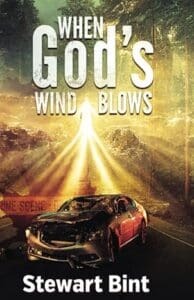 Click the pic for more on Amazon!The Interview
Click the pic for more on Amazon!The Interview1. A Sequel: Shadows of Shadows. Although the events of In Shadows Waiting inform Simon’s and other characters’ perspectives and shape their experiences, the stories seem to be quite different: why did When God’s Wind Blows need to be a sequel rather than a standalone? Although I found the sequel’s discussion of events and ideas related (I assume) to its predecessor easy enough to follow, since I read it without first reading In Shadows Waiting, I wondered if I might be missing key information. Beyond what’s in the book description (above), what would you have readers know about the book set forty years prior to When God’s Wind Blows should they decide to start with the more recent volume? How did your feelings about the world of In Shadows Waiting and about Simon evolve during the years that passed before writing When God’s Wind Blows? How has your writing changed?
SB: You’ve hit the nail on the head with your very first question. When I started planning the book, it was never intended to be a sequel. It was going to be a standalone sci-fi novel with entirely different characters – no connection to the Reynolds family at all.
My original idea was that the movements in time would be part of a scientific project, with a scientist being the main character. As I was plotting the storyline I couldn’t see a feasible ending, and there was no conflict, so I quickly realised that I needed to change direction. I switched the time movements to become the paranormal events they are in the book today, and the scientist became a retired police inspector. The conflict was going to be between that character and a criminal he caught 25 years earlier, who has just been released from prison.
This raised another barrier, though, in that I’d need to devote considerable time to getting a hard-nosed ex-policeman to accept the paranormal, which could take several chapters. So, who did I know who’s already accepted the paranormal and gone through a horrific paranormal experience? Simon Reynolds, nearly 40 years ago.
Re-reading In Shadows Waiting, I saw how easy it would be to link the two stories and have the cause of events in When God’s Wind Blows directly connected to what had happened in the original book.
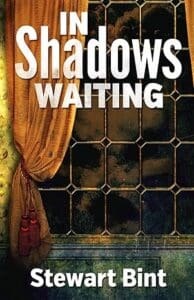
The important points from In Shadows Waiting are all dealt with through Simon’s flashbacks and memories, which I hope I handled in a realistic way. Although readers of In Shadows Waiting would learn more about Simon’s early years and experience the gradual paranormal buildup to the horrific shattering climax of events in 1982, When God’s Wind Blows can be enjoyed in isolation from it.
It was wonderful to get back inside Simon’s head and discover what’s been happening in the years since I said goodbye to him. Set in 1982, the time of In Shadows Waiting is much simpler than today’s world – it’s the start of the computer era and includes scenes of Simon with his £2,000 Amstrad Multimedia PC and a Commodore.
Overall, since that first book, my writing has become more brutal but balanced out with humour. Both aspects are found in abundance in When God’s Wind Blows.
2. COVID Phenomenology. Your introduction to When God’s Wind Blows mentions people who helped enrich your understanding of the experiences of COVID and Long COVID, experiences you describe in great detail from initial symptoms through the disease’s deadly onslaught and into its nightmarish lingering. Why was capturing these details important to you? During quarantine, many artists stayed busy (what else were we supposed to do?), but your book immersed me in the terrors of COVID more than any other book or film I’ve yet encountered. Would you describe the book’s immersion of the reader into the suffering of the disease as COVID horror? Why or why not? Do you think that, as the world has more time to reflect on the global disaster, we’ll see more artistic attempts to wrestle with people’s experiences in genres akin to horror (or “paranormal crime thriller”)? Why or why not?
SB: As the book relies on readers’ acceptance of something outside their everyday experiences and lives, capturing real-life details was of paramount importance in nudging the unbelievable towards being believable.
Yes, I believe what starts out as Simon’s COVID nightmare turns into horror, both for him, and, as the story develops, for the rest of the world. Although my publisher was happy with the COVID storyline, a number of publishing houses publicly said in the aftermath of the pandemic that they wouldn’t touch fiction which focuses on it. I personally think that’s a short-sighted approach, and believe that over time, as the memory of COVID fades for the lucky ones who escaped unscathed by the initial infection, and later by Long COVID, novels will emerge reflecting diverse perspectives.
3. Coma and NDE. Your book extends its phenomenological reach when it explores the experience of a medically induced coma, an area that seems to defy reliable documentation. How much do you feel that your representation of coma experience is factual—typical of what a coma patient encounters—and how much is fictionalized? Why do you feel the way you do? Similarly, your book chronicles Near Death Experience (NDE), a popular topic in paranormal nonfiction less often explored in fiction. What were your sources for representing NDE, and how confident do you feel about having gotten it “right?” Why are the mysteries and terrors of coma and NDE so important in the book?
SB: For the story to be believable, it’s absolutely vital that unknown quantities such as what patients experience in medically induced comas are as realistic as possible. That’s the reason I focus in great detail on what happens in the run-up to those scenes – for example, life on the wards and the medical procedures were all written after extensive interviews with junior doctors. That leads to what I hope is a seamless transition from well-documented real-life situations to the paranormal scenes.
While we only have unverifiable testimonies from people who’ve experienced NDEs while in comas, I wanted to make what happened to Simon as believable as I could. I carried out an extensive interview with someone who had a brief out-of-body experience while in a diabetic coma for several weeks. Simon’s experiences when he physically leaves his body, both in a medically induced coma and towards the end of the book, are a fictional representation of what she saw during her ‘journey.’ So, I’m confident that any reader who’s had a similar experience can identify with at least part of what happens to Simon on the other side of the portal.
Many of my novels have a paranormal element, reflecting on what might happen after death. For example, In Shadows Waiting touches on reincarnation, and we have spirits existing in another plane of existence; To Rise Again explores reincarnation more fully but with a violent and brutal storyline; my satirical novel, The Jigsaw And The Fan, looks at ghosts and the afterlife of Heaven and Hell in a wildly humorous, slapstick, style; while When God’s Wind Blows looks at existence after death both as individual spirits and as becoming one with the spiritual universe.
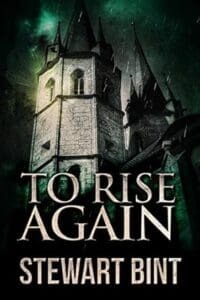
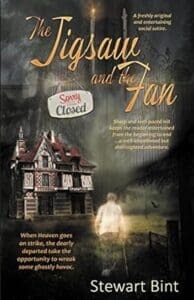
4. Life After Death. Through coma, NDE, and other experiences at the limits of consciousness, When God’s Wind Blows seems to endorse the idea that some aspect of a human individual continues beyond death. Does or do specific religious perspective(s) inform this idea? Would you consider this idea to be a “message” in the book? Why or why not? Despite the book’s terrors of disease and violent death, it offers many promises of hope. Do you see your depiction of a realm beyond death as the book’s greatest reassurance, or might you emphasize other reassurances—such as family and community–instead?
SB: Yes. Absolutely, to all your questions in Part 4.
My four paranormal novels each explore different ways of humans continuing after death in some form or another – individual ghosts, spirits, reincarnation, even one character who was violently raped and murdered centuries ago becoming a guardian angel in When God’s Wind Blows.
So, that’s definitely the message, not only from this book, but from most of my others, too. And I think that whole concept can be traced back subconsciously to my earliest fiction as a young child. I started writing little sci-fi stories from the age of seven. My fictional worlds became invaluable to me when my Dad died when I was 11. I retreated more and more into those places where I was in control of my characters’ fates, knowing that whatever happened to them in the stories, they’d be okay in the end. My fictional worlds were certainly better than the real one at that time.
Let me pose a question to everyone reading this, that I’ve been pondering for years. My Dad’s death had a profound and lasting effect on me. Do you think the message in my books about death not being the end is my way of hoping that my Dad never really left me, and still exists in another plane?
5. COVID’s Physical and Psychological Legacy. Simon and his family endure many physical and psychological traumas because of his struggle with COVID, traumas readers are likely to connect to experiences they witnessed or endured themselves. Taking Simon as a figure for what whole communities (and to an extent the entire world) endured, how does your book reflect on the ways COVID might have changed people’s perceptions of and relationships with their bodies and with public health concerns? Similarly, how does your book reflect on the mental health concerns created by and related to COVID—what is the pandemic’s psychological legacy?
SB: The pandemic meant many people had to fight a lonely battle against COVID, and while it was horrific at the time, I suspect the memory is beginning to fade for most, now, as the brain seeks to protect them. Overall, I believe COVID brought good health and fitness into close perspective, making most people more aware of how vulnerable their bodies can become. It also split public opinion over the battle between personal freedoms and the collective safety – to quote Mr. Spock from Star Trek: “The needs of the many outweigh the needs of the few.”
The long-term mental health effect is likely to be different from the physical aspects of COVID, especially on the young, after the enforced lockdowns promoted feelings of being disconnected. But maybe the pandemic’s lasting legacy is that it has normalised discussions about mental health and shown people – men particularly – that it’s okay to talk about their mental health and to ask for help.
6. Paranormal Time. When God’s Wind Blows flows too smoothly, I think, to be labeled “experimental,” but it does have an unconventional narrative structure that moves back and forth in time, notably beginning with the murders mentioned in the description above, jumping backward, and not coming back to the murders until the novel is about seventy-five percent complete. Why did you choose this approach? How did the non-linear structure affect your writing experience? How do you expect it to shape the reading experience? I’ll risk a bit of a spoiler and say that non-linear time relates to some of the book’s paranormal elements. Without giving away much more, can you explain your (or at least your book’s) understanding of how time operates in a universe where paranormal forces interact with everyday people living everyday lives? Why does it work that way?
SB: I like to open my books with either a burst of action, or something that teases the way forward. Alternating the early chapters showing the murder and start of the police investigation, with Simon being infected with COVID and highlighting some of his background through memories and flashbacks, before parking the murder on a cliffhanger, showed both roads the story would take. If everything in When God’s Wind Blows was done in strict chronological order, I don’t believe the tension would have been built as successfully as I hope it did. I appreciate the non-linear structure may require additional concentration, but I like to think everything was sufficiently signposted, and readers didn’t get lost on the way.
Throughout the book, time works in a normal way for everyone except Simon, and the paradox is that he began to experience something in 1982 which wasn’t created until COVID in 2020. I love paradoxes, especially a huge one in my time travel novel Timeshaft, where the main character uses the Timeshaft to travel back in time to create the Timeshaft itself, and the entertaining scene where the time traveller has dinner with his mum and dad when she’s pregnant with him!
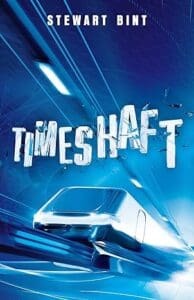
7. Terrorism. After the murders that begin the novel, authorities—with trepidation—speculate that they might be acts of terrorism. What inspired you to weave the possibility of terrorism together with a chronicle of the pandemic? As some of your characters eventually reflect, one of terrorism’s goals is to make everyone feel unsafe, and though a deadly disease might not have a “goal,” it arguably has the same effect. In this sense (within your pages), are terrorism and COVID mirror images of each other? Why or why not? Returning to matters of genre, terrorism shows up most often in action-adventure stories, sometimes thrillers, but considering that its focus is, well, terror, do you think it’s more at home with horror and the types of stories where the paranormal might appear? Why or why not?
SB: I brought terrorism into the novel to be the conflict that had been missing from the original concept when it was going to be a sci-fi story. The protagonist [or the person who becomes the antagonist, from Simon’s perspective–LAC] made what everyone else believes is terrorism to be a mirror image of COVID because he genuinely believes it is God’s will. So, it poses the question, ‘Which is truly God’s Wind? – is it COVID, which he believes God sent to wipe the infestation of humanity from the face of the Earth, or is he God’s wind, in trying to prevent humanity’s fightback against it?
Terrorism can take many forms, and, indeed, one Amazon reviewer of When God’s Wind Blows says: “He has taken the events of the last several years and built a story that absolutely scared me to my soul. Stewart has, in this story, shown us just how easily a terrorist cell could take advantage.”
Terrorism is defined as ‘the unlawful use of violence or threats to intimidate or coerce a civilian population or government, with the goal of furthering political, social, or ideological objectives. It involves acts that create fear and harm for a political, ideological, religious, or economic objective.’
Using this as the guide, I’d say that stories in any genre could revolve around terrorism in some form.
8. Apocalypticism. Apocalyptic, often Biblical rhetoric wasn’t uncommon as people grappled with the horrors of the pandemic, a phenomenon your book’s title seems to foreshadow and that your story does address. What’s your view of people’s readiness to embrace apocalyptic thinking in the new millennium? Does your book take a position on this tendency? For many, COVID felt like a personal apocalypse, but how much do you want your readers thinking about a future of more plagues and other forces that threaten the globe? Is the world of your novel spiraling inevitably toward its end?
SB: Not sure the world in When God’s Wind Blows was spiraling towards its end, but, of course, in the final section, entitled ‘Afterwards,’ I do say maybe the Earth isn’t finished with keeping humankind in check and could show us in other ways that while mortals think we’re in charge of our destiny, in truth, we’re not.
The Doomsday Clock has been so close to midnight for many years now, and the news media is full of situations where an apocalypse could be triggered, that I think people have become immune to the idea of it. It’s something we all think about when we worry about the future of our children and grandchildren, but we don’t really see it happening. The thoughts are that humanity will step back from the brink. However, When God’s Wind Blows’ stance on this is that supernatural forces had to combine against the protagonist, so maybe humanity isn’t as smart as we think we are.
9. “Evil Stuff in the Name of Grief.” When God’s Wind Blows deals with many traumas in addition to those tied to COVID, and some of those traumas, left unresolved, lead to grief that motivates villainous behavior, something the villains in both In Shadows Waiting and its sequel have in common. Why did you choose to make grief such a strong motivator for your villains? What about grief brings on a tendency toward “evil stuff?” On individual and cultural levels, how might we process the grief over tragedies like the losses of loved ones—to COVID or to other forces that seem unjust—and avoid the sorts of evils that your stories depict?
SB: Both villains had originally been good people, but I wanted to show how one force could be so powerful that it affects the stability of their minds. Grief was the plot device to portray that powerful force, which, in In Shadows Waiting, affected only one family, but extended to real “evil stuff” in When God’s Wind Blows to twist one man’s sanity so much that it drove him to potentially destroy the whole world. Grief ain’t to be messed with! And it becomes even more powerful when you realise it’s two people grieving over the same person – one in In Shadows Waiting, and one in When God’s Wind Blows.
10. Access! How can readers learn more about you and your works (please provide any links you want to share)?
SB: My combined website and blog is the best way to find out all about me and my books: Stewart Bint Author – Home. You’ll find individual book links to Amazon and a couple of other outlets, under the Fiction tab there.
My Facebook author page: Facebook
I’m always happy to connect with anyone on X (formerly Twitter): @AuthorSJB, and Bluesky: @stewartbint.bsky.social.
About the Author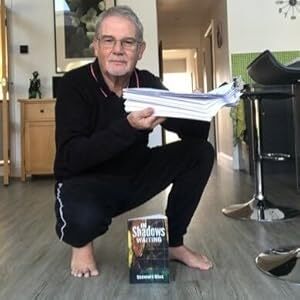
Stewart Bint is a novelist and magazine columnist. He lives with his wife, Sue, in Leicestershire in the UK, and has two grown-up children, Christopher and Charlotte, and spends a lot of time now with his young grandson, George.
He is a former PR writer, radio presenter, newsreader, and phone-in show host, but he always wanted to be a fiction writer—a dream that came true when his first novella appeared as an ebook in 2012 at the age of 56. His first paperback came out three years later. When God’s Wind Blows is his sixth book, and the sequel to his first novel, In Shadows Waiting.
The post Interview with Author Stewart Bint: When God’s Wind Blows appeared first on L. Andrew Cooper's Horrific Scribblings.
April 9, 2025
Interview with Author D.L. Winchester: The Screaming House
D.L. Winchester brings a wealth of knowledge and experience to his western horror novella The Screaming House, a page turner with depths he throws light on in this interview.
The Screaming HouseGetting under Judge Ray Spencer’s skin doesn’t get you sent to prison—he’ll drag you to the Screaming House.
Bounty hunting duo Aggie and her father, Roche, track their latest prey—two bank-robbing outlaws—in the unfamiliar town of Briar Hill. But when Roche guns down the outlaws at the local saloon, their brother turns out to be the town’s judge, Ray Spencer. Roche is sentenced to hang, but Aggie steps up and aids him in his escape—playing right into Spencer’s hands. Spencer captures Roche and hauls him to his isolated logging camp, dubbed “The Screaming House,” to avenge his brothers’ deaths.
Can Aggie rescue Roche from the bloodthirsty Judge Spencer? Or will the Screaming House swallow them both?
Follow them to their fate in D.L. Winchester’s grisly western horror novella, THE SCREAMING HOUSE.
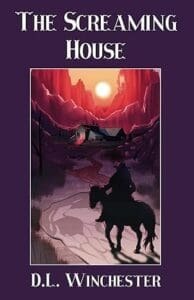 Click the pic for more on Amazon!The Interview
Click the pic for more on Amazon!The Interview1. How Far West Is Horror? It doesn’t have strange creatures or supernatural elements, so what makes The Screaming House both western and horror? What dimensions make the story not just set-in-the-late-1800s-American-West but western and likewise not just bloody and violent but horror? To the latter point, I’ll give away that torture is involved, torture that does get grisly. Do you think it’s torture porn? Why or why not? For Ray Spencer, watching torture provokes a porn-like sexual response. Does his response to horrific violence reflect on displaying or enjoying it in art (such as writing and reading it in your book)? Is this response part of being “horror?” Why or why not?
DLW: I don’t accept the idea that for something to be “horror” it has to have strange creatures or supernatural elements. Some of my favorite horror writers, Jack Ketchum, Mort Castle, and Steve Gerlach, rely on human evil to create horrors that are, in my opinion, worse than creatures/the paranormal. This isn’t to say I don’t ever write horror that contains creatures/the paranormal. In fact, in the sequel to The Screaming House, the villains fall into both categories (Devil’s Fork is scheduled for a July 18, 2025 release from Undertaker Books). But I don’t think those elements have to be there for horror to exist.
The Screaming House was written to have strong notes of extreme horror and splatterpunk without fully submerging the reader in those genres. I decided to write it after reading a “Splatter Western” and thinking, “I can do this better.” Both those genres definitely have elements of torture porn, and I think Ray Spencer’s character and actions help lend credence to the “horror” side of horror western.
At the same time, I like your question about what makes the story “not-just-set-in-the-late-1800s-American-West,” because I think that is a defining motif of the western genre. To me, it seems to be as much about the setting as it is the tropes that define it. Frontier life was difficult and brought many unique struggles, both real and exaggerated. I think showing those struggles and the response to them is as much “western” as two men staring each other down at high noon.
I didn’t explore Spencer’s sexual needs as much as I could have in The Screaming House, but I’d like to think his needs grew over time rather than all at once, and there was a point where depictions of horror in art and writing would have been enough for him. But at the same time, living on the frontier, getting his hands on the kind of art needed to satisfy those needs would have been a challenge in itself.
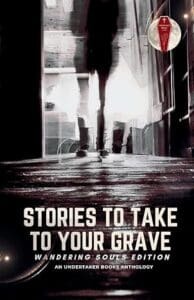 Winchester does reach into the more speculative side of horror…
Winchester does reach into the more speculative side of horror…2. Gun Gore. While The Screaming House offers a variety of imaginative ways for the human body to get smashed, punctured, slashed, dismembered, etc., the mainstay of violence is gunfire that ends in gory descriptions of chests ripped open and heads blown apart. Why the attention to bullets’ physical impact, which is usually quick and over in far less time than necessary to read your descriptions? Do you intend a kind of slow-motion effect with these descriptions? How do you expect readers to respond to representations of what bullets actually do to bodies, something sanitized in the traditional western? Does the extremity of the violence reflect on the western’s tendency to glorify guns? Why or why not?
DLW: I spent almost a decade working as a mortician, and as part of my training, we dissected cadavers. I’ve seen the inside of human bodies, both in the cadaver lab and when embalming people who have been autopsied/donated tissue and organs, and one of the things that I came away with is a fascination with how brilliantly designed the human body is, and how one little object, like a bullet, can be enough to bring its functions to a screaming halt.
I’ve also always loved shows and information about how things work and what makes them tick. So, by slowing down and actually looking at what happens when a bullet plows into someone, I’m kind of performing an autopsy for the reader, showing them not just the gunfire, but what happens after the bullet strikes. Which does slow things down a little and isn’t something commonly seen in westerns. But I think one of the great things about writing is that it’s always evolving, and if a genre hasn’t evolved to include something you’d like to see, you can introduce it in your work.
While what bullets actually do is somewhat sanitized in westerns, they are also given an almost mythical level of striking power. One hit, and the target goes flying over the saloon! (I’m exaggerating here, but only slightly). “Western” gore isn’t always realistic, and as someone who likes things to be as realistic as I can, getting to show the actual damage is a way of doing that while maintaining the inherent gore of horror and the gunplay of a traditional western.
As far as westerns “glorifying” guns… I think in a good western, a gun is a tool, an extension of the man carrying it. When you move the focus away from the character to focus on the gun in his hand, it’s a disservice to the character. A character who kills will kill no matter what weapon is available to him, and in westerns, guns just happen to be one of the more convenient ways to kill.
3. Assault on Masculinity. Speaking of traditional westerns, they usually feature rugged male heroes who model masculinity and generally beat the bad guys against the odds. Your novella offers two male protagonists, Tidwell and Roche, neither of whom fits the John Wayne archetype. On the first page, Tidwell is in tears, and we learn that his balls have been crushed. Why begin with an image of not only a man crushed but manhood specifically crushed? Do you think your book is, on some level, about the failure of the masculinity offered by the traditional western? Roche seems poised to do no better than Tidwell, and as the description above indicates, he needs rescuing from his daughter not once but twice, something unthinkable to the manly man of old. Does his reliance on his daughter diminish him? Why or why not?
DLW: I will say Tidwell was never intended to be a protagonist—his portions were added after the first draft was finished. I wanted to bring a somewhat neutral perspective to the story and add some length, so as I thought about whose perspective would be the most beneficial, I found myself wondering what the story would look like to the guy on the cross, so Tidwell’s character was expanded.
As far as the first page, I wanted something brutal, pretty much the worst thing you could do to someone without actually killing them that would have both a physical and psychological impact. As a man myself, the thought of the castrati from religious history has always sent a chill down my spine, so applying a similar idea to Tidwell got the effect I wanted.
“Failure of masculinity” might be reading more into my work than I ever did! I don’t tend to think about the message my work will have while I’m writing it. I’m mainly thinking about characters and what they can do that makes me interested in their story. But when The Screaming House was released a week before the 2024 Election, I definitely noted some parallels between my book and the main contenders in the election. Was it a happy accident? Yes, but it was the kind of accident that made it look like I had ulterior motives.
Roche needs rescuing from his daughter more than once or twice. In fact, part of their backstory (which I can’t remember if I mention in The Screaming House or a future Aggie adventure) is that when they first meet, she’s rescuing him after another pair of villains has left him for dead. The main thing I wanted to get across was that Roche sees Aggie as an equal. I don’t think that’s a failure of masculinity as much as an elevation of it, being willing to look outside the societal norms and understand something others may not be willing to and use it to his advantage.
As I wrote the story, my daughter was one year old going on thirty, but one of the things that strikes me in my own life is how often she rescues me, running to me for a hug, blowing me kisses, and making me feel like I’m the center of her world. Aggie is a lot of what I hope Wednesday will grow up to be. Aggie is his ace in the hole, a secret weapon none of the men around him would expect or respect, and it tends to play to his advantage.
4. The Woman Hero. And speaking of Roche’s daughter, Aggie—as the person stuck with doing most of the rescue activities, she mostly seems like the hero of the piece. Why make a young woman the hero of your western horror novella? How does having a woman do most of the gunslinging change how you think and write about western genre conventions? How much do you think readers relate to Aggie’s strength and resourcefulness? Aggie and the other female character who receives the most attention, Millie, are both sex workers or, in the parlance of the novel and times, whores. Why? Is this role problematic, empowering, or both?
DLW: Because though I enjoy a good damsel in distress, while I was writing The Screaming House, I realized a story focusing on Roche trying to save Aggie would be, at best, lost in a sea of similar stories. Also, Spencer has no idea Aggie exists, so it was fun to build her up as a secret weapon while Spencer focuses on Roche. It was a decision that could have gone either way, but in the end, I decided to make Aggie the rescuer and see what happened.
I think readers will relate to Aggie as an underdog at first, but as they get to know her, there will be a growing sense of, “Oh shit, Spencer bit off more than he could chew.” Which I think relates more to the horror side of the story, where the main character often has to grow into their role before the ultimate victory. It is western horror, after all, merging elements from both genres, and bringing Aggie in as a hero is a nod to the horror side of tradition, as well as another horror trope that would give away too much of the story to mention here.
One of the Facebook reels I’ve been watching lately is from a creator called “Modern Working Girl,” a legal sex worker in Nevada. She talks a lot about the industry, what the job entails, and how she deals with clients, and one of the most striking things about her is that she seems to have her shit together, on a level I saw in the best NICU nurses when my son was in intensive care. That makes me think the job can be empowering, if a person chooses to make it empowering, as Aggie does. It was a case where I needed Aggie in the saloon, in a role where she wouldn’t be noticed, and that was the position that worked best for the story. But as the story goes on, we see how she is able to use that position to her benefit.
I honestly hate to say that I don’t know as much about Millie as I do Aggie. I didn’t develop her as deeply as a character because I didn’t need to: I needed a way for Spencer to hurt Tidwell on a psychological and emotional level, and a woman fit the bill. It would be interesting, at some point, to go back and write the story of Millie and Tidwell, just to get to know her better and see how their relationship developed. But until then, I don’t have a lot of answers about her.
5. Really Bad Bad Guys. Your main villains, Judge Ray Spencer and his sidekick the Doctor, are totally sicko sadists. I don’t think they’d flinch at that label. In fact, at one point the Doctor embraces it with glee. As I’ve mentioned, Spencer’s sadism is in part sexual—he literally gets off on torture. What else drives his lust to inflict pain? What drives the Doctor’s? Does either of these characters have any redeeming qualities? Why or why not?
DLW: At the time, the Doctor was the most fucked-up character I’d ever written. Since then, I’ve finished other drafts and have created more characters who are even more fucked up that you’ll see in the future. I think there’s an interesting dynamic between the Doctor and Spencer in that they need each other: the Doctor needs Spencer for protection, and Spencer needs the Doctor for sexual satisfaction. But as far as what actually drives them, I think the Doctor has a similar psychopathy to modern serial killers like John Wayne Gacy: he tortures and kills because he can, and he won’t stop until he’s stopped.
Spencer is more nuanced, I think. The question the Doctor asks Roche tells us a lot about Spencer: “If you were in his situation, would you make the same choices?” It’s a difficult question to answer for me personally, and I hope it is for the reader, and I hope it gives them at least a moment of reflection.
As far as redeeming qualities, I don’t see the Doctor having any, but I think there are definitely two sides of Spencer, the side on public display when he’s in town and serving as a judge, and the side we see at the Screaming House. Even if the Screaming House is an open secret in town, I think Spencer would strive to be seen as a prominent, upstanding citizen when he is not at the Screaming House. That would be part of how he keeps his support system in place, and how he keeps the people around him loyal to him.
6. Kind of Bad Good Guys. Do good and evil exist in the world of The Screaming House? Looking at Spencer, I might believe in evil, but good is tougher. Tidwell gets in trouble with Spencer because he’s a thief, and Roche and Aggie are bounty hunters who kill people for a living, so our candidates for “good guys” aren’t… great. Why no knights in shining white armor? Does Tidwell care about being “good?” Does Roche? Why or why not? When things get bad, both men fantasize about doing the same sadistic things to the bad guys as the bad guys do to others. If their sadistic acts are what make the bad guys so bad, are the… other… guys just as bad, at least potentially? Why or why not?
Perfect heroes are boring.
D.L. Winchester
DLW: Perfect heroes are boring. I’ll start by saying that.
Aggie and Roche are not upright John Wayne types. If anything, they’re Clint Eastwood in The Outlaw Josey Wales or Christoph Waltz and Jamie Foxx in Django Unchained, doing what they must to get by. If that means bringing a man in dead, it’s what they’re going to do. As I mentioned earlier, frontier life was hard, even if some of the challenges are exaggerated in modern times. Sometimes, the priority has to be survival before character.
Tidwell is a more interesting case because I think his desire to escape Spencer was driven from a desire to be good, or at least better. He didn’t want to be associated with what Spencer was doing at the Screaming House, and he saw his chance to escape, even though it involved theft, something that is bad. Do good men sometimes have to do bad things to make things better? Is stealing from a bad man as bad as, say, stealing from Mister Rogers? Those are the kind of questions that Tidwell brings to readers.
As far as Tidwell and Roche wanting to retaliate against the Doctor and Spencer, I don’t know that I would say their response makes them just as bad. A human response to the kind of pain they were put through is “an eye for an eye,” and though it may make the whole world blind, there is a certain satisfaction in retaliation. I think Tidwell and Roche have a human desire to retaliate for what has been done to them, and I think being left in a cell to stew about what’s been done to them would have an effect on them and make them more prone to vengeance in kind.
7. Perspective. Your relatively short novella breaks into 54 brief chapters, with each chapter break shifting from the perspective of one character to another, telling the story from Tidwell, Roche, and Aggie’s points of view. Why did you choose this approach? How does it shape the way we understand the story overall? What do the limitations of their perspectives cost the characters, and how do the limitations help add to readers’ involvement in the story’s development? What sort of character arcs, or developments in these perspectives, should readers expect?
DLW: So initially, the book was broken into more traditional chapters, alternating between Aggie’s perspective and Roche’s perspective. But when I added Tidwell, it created an imbalance: there wasn’t a good way in the traditional chapter format to make sure the reader knew which perspective they were seeing at that point. So, Rebecca (our EIC at Undertaker Books) suggested using short chapters, and I thought that was the best solution.
I think the varied perspectives give the reader a better overall view of the story, especially having added Tidwell’s perspective. To me, that was the most important addition to the story in the editing process.
I’m not sure that the short chapters limit the reader’s perspective as much as they enhance it. I like the way the short chapters give a better “real time” view for the reader without forcing them to see certain events through a single character’s eyes. I think it’s a way to keep the reader more involved with the details of the story as a whole.
It’s definitely a case where I think this style of storytelling is most beneficial for this story, but my next Aggie book, Devil’s Fork, will have a more traditional chapter structure because it’s what works best for that story.
8. Shadows of an Uncivil War. Although it’s a natural topic for the time period, the U.S. Civil War comes up often enough in The Screaming House to seem noteworthy. What is its significance to the characters and the story? Do you think memories of the war’s atrocities contribute to the casualness with which characters inflict and receive violence? A little more grandiose—did the Civil War desensitize America? Why or why not? Villains in your novella seem to have fought for the Confederacy, but I’m not sure about the other guys… does whose side a character fought on matter in your world? Why or why not?
DLW: So I’m a big Civil War buff, and it creeping into my work is natural. The Civil War also plays a big role in Roche’s back story, which we’ll get into more in the fourth Aggie adventure, tentatively titled Ojinaga. I think the Civil War and its immediate aftermath was the perfect kind of chaotic environment for someone like the Doctor to operate without being brought to justice.
Did the Civil War desensitize America? Wow. That is a grandiose question, and one I want to roll the previous question into. I can’t imagine seeing violence on the scale a soldier in the Civil War would have seen and not being desensitized. As previously stated, I was a mortician for nine years, and one of the defenses you develop against the job is a certain level of disconnection to the impact of death. Actually being the one inflicting death and witnessing the outcome of those battles, I can’t help but think a greater sense of disconnection would be necessary to survive, and that it could certainly endure long enough after the war to affect these characters. As far as America as a whole? I definitely think it’s possible.
Getting back into the Civil War history side of things, I’m from East Tennessee, which was one of the most pro-union areas in the south. I’ve got ancestors who fought on both sides, but I’m not a lost cause apologist. I think there is complexity and nuance to the history, but, big picture, the Confederacy was in the wrong and deserved to lose the war.
But it’s hard to argue historical nuance in the space of a novella (Michael and Jeff Shaara do a brilliant job of this in their Civil War novelizations, and they also use multiple perspectives on a larger scale), so I do kind of rely on the “Confederacy is bad” narrative to establish my villains as evil. Roche was a Yankee, and there is back story to be revealed in Ojinaga that will explain just how much of an effect the Civil War had on both his and Aggie’s lives.
9. Unchecked Power. As your book’s summary indicates, Ray Spencer is a judge, and corrupt government allows him to get away with his crimes. This kind of corruption isn’t uncommon in the western—do you think it was widespread in the times of your novella? Do you think the kind of unchecked power that Spencer represents is common today? Why or why not? At one point, Spencer says, “‘justice for those who understand civilization is its own form of insanity.’” What does that mean? Is he right? Why or why not?
DLW: I think that in Westerns, you need a villain, and corruption is an easy way to create a villain. As far as it being a historical fact, I’m undecided. I’d like to think that those with the independent spirit of the west wouldn’t have tolerated it, but at the same time, humans will be human, and corruption is definitely human.
As far as unchecked power being common today, that’s another grandiose question. Here in America, I think there is a leader that aspires to that kind of unchecked power, and it remains to be seen if he will be successful in attaining it. As Lord Acton said, “Power tends to corrupt, and absolute power corrupts absolutely.” The struggle for power will always exist, and with it will come a desire to remove the guardrails on that power.
The context of that statement, “Justice for those who understand civilization is its own form of insanity,” is important. Spencer was referring to a punishment being carried out outside the law, and he was implying that following the law in that case would not lead to justice actually being served. It gets back to the idea of unchecked power and an idea that justice should be what the person with power wants it to be, not necessarily what society thinks it should be. As far as if Spencer is right or not, I’d say your answer will depend on whether or not you’re the one with unchecked power.
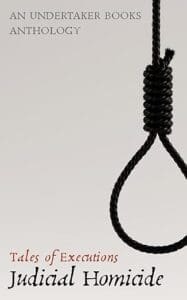 Winchester raises more questions about “justice”
Winchester raises more questions about “justice”10. Access! How can readers learn more about you and your works (please provide any links you want to share)?
DLW: I am on Facebook and BlueSky at the links below, and I also write regularly on the Undertaker Books blog. I’ve got three books published to date, and several more in various stages of being prepared for publication. Eventually, I will put together a website to put everything in a central location, but until then, Facebook is your best bet!
Facebook: www.facebook.com/writerdlwinchester
Bluesky: https://bsky.app/profile/dlwinchesterwriter.bsky.social
Undertaker Blog: www.undertakerbooks.com/blog
About the Author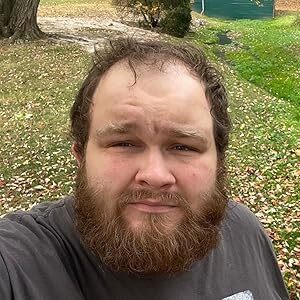
D.L. Winchester lives in the foothills of southern Appalachia. A former mortician, his work searches the darkness to find tales worth telling. He is the author of over three hundred obituaries, numerous short stories, the novella The Screaming House, and the collections Shadows of Appalachia and A Terrible Place and Other Flashes of Darkness.
D.L. also serves as the President and Associate Editor of Undertaker Books, an independent horror publisher. In his spare time, he can be found searching for inspiration in the world around him and helping his wife try to keep their children from becoming the next generation of horror villains.
The post Interview with Author D.L. Winchester: The Screaming House appeared first on L. Andrew Cooper's Horrific Scribblings.



